Archived Blog Posts
Safe Mold Cleaning Products for Your Home
3/13/2024 (Permalink)
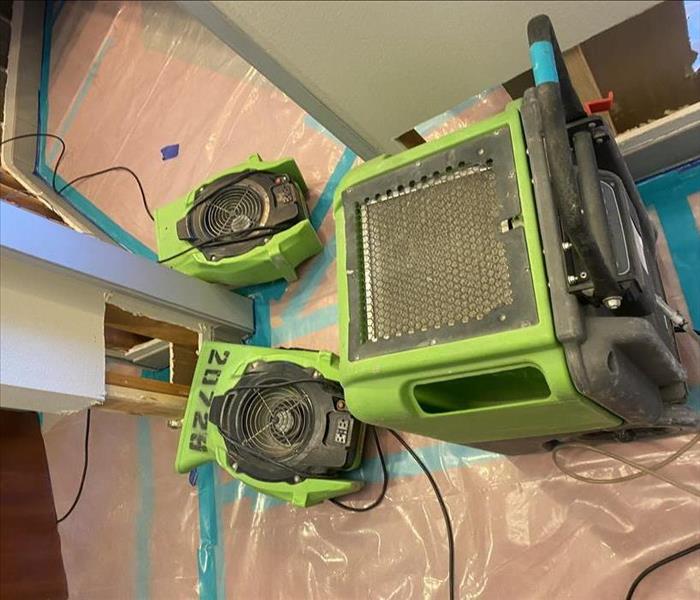 In this blog, we will explore safe mold cleaning products that are OSHA and EPA-approved and can be used in the home.
In this blog, we will explore safe mold cleaning products that are OSHA and EPA-approved and can be used in the home.
Mold is a common problem in many homes, especially in damp or poorly ventilated areas. Mold can spread quickly and pose potential risks to your home. Cleaning up mold in your home is essential to maintain a safe living environment. However, selecting the right cleaning products is crucial, as not all products are created equal. In this blog, we will explore safe mold cleaning products that are OSHA and EPA-approved and can be used in the home.
Understanding OSHA and EPA-Approved Mold Cleaning Products
OSHA Approved Products: The Occupational Safety and Health Administration (OSHA) gives guidelines for using cleaning products safely and effectively. OSHA-approved mold cleaning products are specifically designed to combat mold and are certified to ensure safe use for humans and the environment. These products contain specific ingredients, such as sodium hypochlorite and hydrogen peroxide, that have antimicrobial properties, killing mold and other harmful bacteria effectively.
EPA-Approved Products: The Environmental Protection Agency (EPA) provides a label certification program for mold cleaning products to ensure they are safe for use. EPA-approved products undergo rigorous testing to ensure they are effective and free of harmful ingredients. These products often come in the form of "Green" options that promote a more sustainable and eco-friendly approach.
Safe Mold Cleaning Products for Your Home
Bleach: Bleach is a common household disinfectant and is also effective at killing mold. The active ingredient in bleach, sodium hypochlorite, effectively targets and kills mold spores. However, bleach can cause health problems when misused and can also damage surfaces, especially porous materials. Ensure proper ventilation and follow safety instructions when using bleach for mold cleaning.
Hydrogen Peroxide: Hydrogen peroxide is a safer alternative to bleach for mold cleaning. It is non-toxic and does not emit harmful fumes. Hydrogen peroxide breaks down into oxygen and water, leaving no harmful residue. It effectively kills mold spores and is safe for use on various surfaces, including wood, fabric, and carpets.
Vinegar: Vinegar is another non-toxic and natural mold-cleaning solution. Its acidic nature effectively kills mold spores and is safer for kids and pets. However, vinegar may not be as effective at killing all types of mold, and its strong odor may be off-putting to some.
EPA-Approved "Green" Products: For a more sustainable and environmentally friendly approach, consider EPA-approved "Green" mold cleaning products. These products are made with natural ingredients and are safer and less harmful than traditional cleaning products. They are also effective at killing and preventing future mold growth.
Mold cleaning is an essential task for maintaining a safe home environment. However, choosing the right cleaning products is crucial for both safety and effectiveness. OSHA and EPA-approved mold cleaning products are the best options for safe and efficient mold remediation. Bleach, hydrogen peroxide, and vinegar are some of the commonly used household products that you can consider for mold cleaning. Additionally, eco-conscious consumers can opt for "Green" mold cleaning products that promote a sustainable and safer approach to cleaning. Remember to always follow instructions and safety precautions when using any cleaning products.
5 Signs of Water Damage Every Homeowner Should Know
2/16/2024 (Permalink)
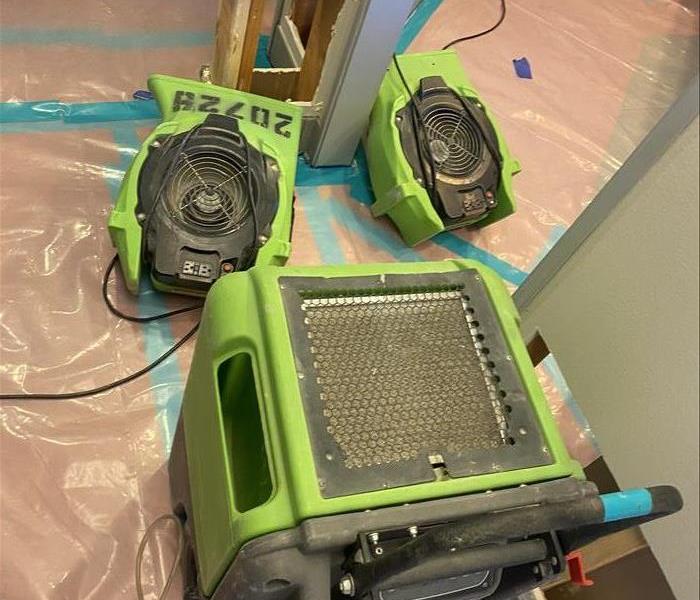 Remember, early detection is the key to preventing water damage from turning into a homeowner's nightmare!
Remember, early detection is the key to preventing water damage from turning into a homeowner's nightmare!
Water damage can be a silent troublemaker in your home, wreaking havoc if left unnoticed. Let's delve into the top five common signs that scream, "Houston, we have a water problem!" - without the need for a detective's magnifying glass.
1. Musty Odors: The Nose Knows
Musty, earthy odors are often the first giveaway of hidden water issues. If your home smells like a dank basement or a damp forest, it's time to investigate. These odors often signal mold growth, a consequence of prolonged water exposure in concealed spaces.
2. Stains and Discoloration: Water's Artwork on Walls and Ceilings
Stains or discoloration on walls and ceilings are like water's artistic signature. These unsightly blemishes can indicate leaks, seepage, or hidden moisture accumulation. Keep an eye out for yellow or brownish stains that hint at water infiltrating your home.
3. Peeling or Bubbling Paint: A Cry for Help from Your Walls
If your walls suddenly start shedding paint or developing mysterious bubbles, it's not a quirky art installation—it's likely water damage at play. Water lurking behind the scenes causes paint to lose its grip, leading to peeling or bubbling.
4. Warped or Buckled Flooring: A Subtle SOS from Below
Floors that resemble a rollercoaster with unexpected dips and rises are sending a clear signal of water issues. Water damage causes wood to swell and buckle, transforming your once-smooth flooring into an uneven terrain.
5. Unexplained Spike in Utility Bills: The Silent Culprit
Your water bills might hold the secret to hidden water issues. An unexplained increase in water usage can point to leaks in pipes, faucets, or appliances. Keep an eye on those bills – they could be telling a tale of water escaping where it shouldn't.
Addressing these common signs promptly can save your home from extensive water damage. If you notice any of these red flags, it's time to put on your detective hat, track down the source of the issue, and call in the experts at SERVPRO of Laguna Beach to ensure your home stays dry and healthy. Remember, early detection is the key to preventing water damage from turning into a homeowner's nightmare!
SERVPRO®'s Role in Restoring Storm Damage
1/14/2024 (Permalink)
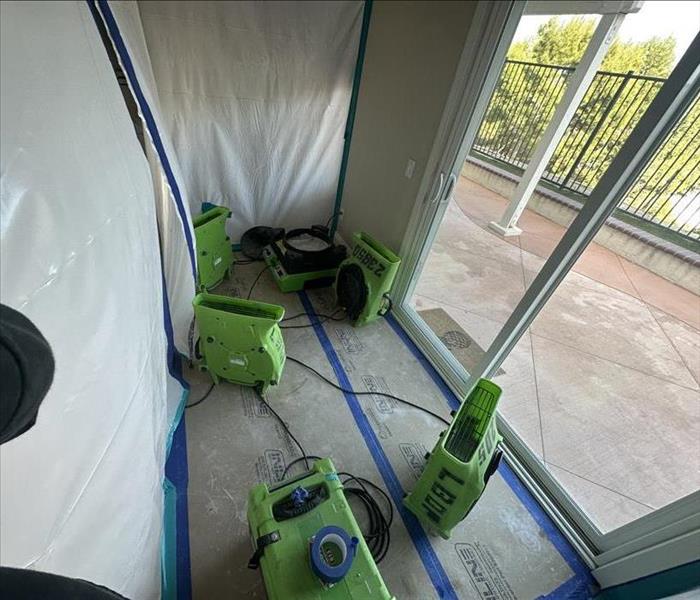 In conclusion, storms can be overwhelming, but you don't have to navigate the recovery process alone.
In conclusion, storms can be overwhelming, but you don't have to navigate the recovery process alone.
As storms wreak havoc, the aftermath often leaves homes and businesses devastated, requiring immediate attention and restoration. At SERVPRO of Laguna Beach, we understand the distress that storm damage can cause, and we're committed to quickly and efficiently restoring your home or business back to its pre-storm condition. Let's dive into the role SERVPRO® plays in storm damage recovery and how our expertise can assist in these challenging times.
Emergency Response and Assessment
When a storm strikes, our first priority is your safety. Our rapid response team promptly assesses the damage, evaluates the affected areas, and devises a comprehensive restoration plan. We employ advanced technologies to gauge the extent of damage, allowing us to create a tailored strategy for effective recovery.
2. Professional Restoration Services
Our team specializes in a wide array of storm damage restoration services. From water extraction and drying to debris removal and structural repair, our trained technicians employ industry-leading techniques and state-of-the-art equipment to expedite the restoration process.
3. Mitigation and Preventive Measures
Acting quickly is crucial to prevent further damage. Our team initiates immediate mitigation measures to safeguard your property from secondary issues like mold growth and structural deterioration. We implement thorough drying techniques, apply antimicrobial treatments, and seal vulnerable areas to prevent future issues.
4. Insurance Coordination and Documentation
Navigating insurance claims can be complex during such distressing times. SERVPRO® assists in documenting the damage, providing detailed reports, and coordinating with insurance companies to streamline the claims process for our customers. Our goal is to alleviate stress by handling the paperwork and communication, allowing you to focus on getting back to normalcy.
5. Commitment to Quality and Customer Satisfaction
At SERVPRO of Laguna Beach, we take pride in our commitment to delivering high-quality services. Our technicians undergo rigorous training and adhere to industry standards to ensure that every restoration project meets or exceeds our customers' expectations. Your satisfaction and peace of mind are our top priorities.
Why Choose SERVPRO of Laguna Beach?
- Experience: With years of experience in storm damage restoration, we have honed our expertise to efficiently handle various types and scales of damage.
- 24/7 Availability: Storms don't follow a schedule, and neither do we. Our emergency services are available 24/7, ensuring we're there when you need us the most.
- Community Involvement: As a part of the community, we understand the importance of supporting our neighbors during challenging times. We strive to be a dependable partner in recovery efforts.
In conclusion, storms can be overwhelming, but you don't have to navigate the recovery process alone. Our team stands ready to assist you in restoring your property and providing the support you need during these trying times. Contact us immediately after a storm for prompt, professional, and reliable storm damage recovery services.
The 6 Key Steps of Fire Damage Restoration
12/20/2023 (Permalink)
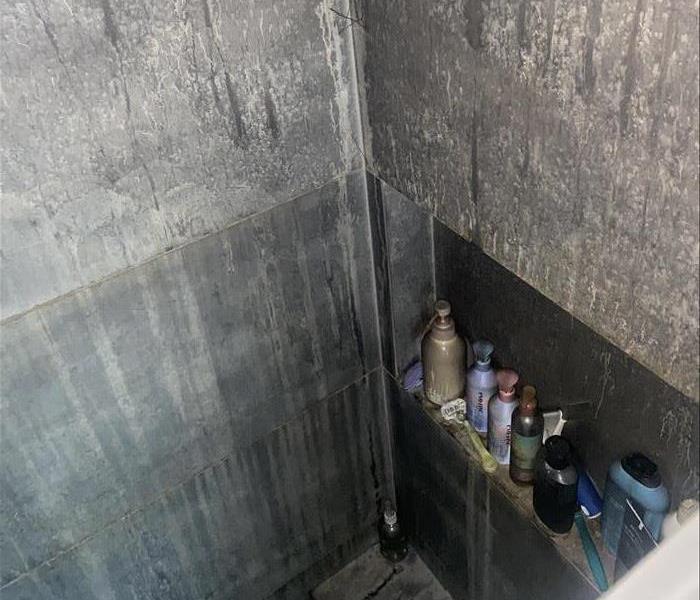 Experiencing a fire is a traumatic event, but knowing the key steps of fire damage restoration can provide reassurance during a challenging time.
Experiencing a fire is a traumatic event, but knowing the key steps of fire damage restoration can provide reassurance during a challenging time.
Facing the aftermath of a fire can be an overwhelming and distressing experience. However, understanding the process of fire damage restoration can help ease your worries and ensure a more efficient recovery. In this blog, we will outline the six crucial steps of fire damage restoration, shedding light on how professionals like SERVPRO® work to bring your property back to its pre-fire condition.
1. Emergency Contact and Assessment
The first step in fire damage restoration is to contact a professional restoration company like SERVPRO of Laguna Beach/Dana Point as soon as the fire is extinguished. Our 24/7 emergency response team will assess the situation, determine the scope of the damage, and provide guidance on what steps to take next. Quick action is essential to prevent further damage.
2. Tarp and Board-Up
To secure your property, professionals will tarp and board-up damaged areas. This prevents unauthorized entry, protects against the elements, and ensures safety during the restoration process.
3. Water Removal and Drying
Fires are often extinguished with water or other extinguishing agents, which can lead to water damage. The next step is to remove standing water and thoroughly dry the affected areas. This prevents secondary issues such as mold growth.
4. Smoke and Soot Removal
Smoke and soot residues can cover surfaces and infiltrate building materials. Professionals use specialized equipment and cleaning methods to eliminate these contaminants, restoring your property's air quality and appearance.
5. Structural Restoration
Restoring the structural elements of your property is a critical step. This may include repairing or replacing damaged walls, floors, ceilings, and roofs. Professionals work to ensure your property is safe and structurally sound.
6. Cleaning and Restoration
The final step in fire damage restoration is cleaning and restoring your personal belongings and furnishings. Professionals will carefully clean and deodorize items like furniture, clothing, and electronics. When possible, items are returned to their pre-fire condition.
Experiencing a fire is a traumatic event, but knowing the key steps of fire damage restoration can provide reassurance during a challenging time. By promptly contacting professionals, securing your property, removing water, cleaning smoke and soot residues, restoring structural elements, and cleaning and restoring personal belongings, you can move closer to normalcy and peace of mind. Trust the expertise of professionals like SERVPRO of Laguna Beach/Dana Point to guide you through the process, from assessment to full restoration, so you can begin the journey of recovery with confidence.
Mold and Moisture Control in Commercial Buildings
11/14/2023 (Permalink)
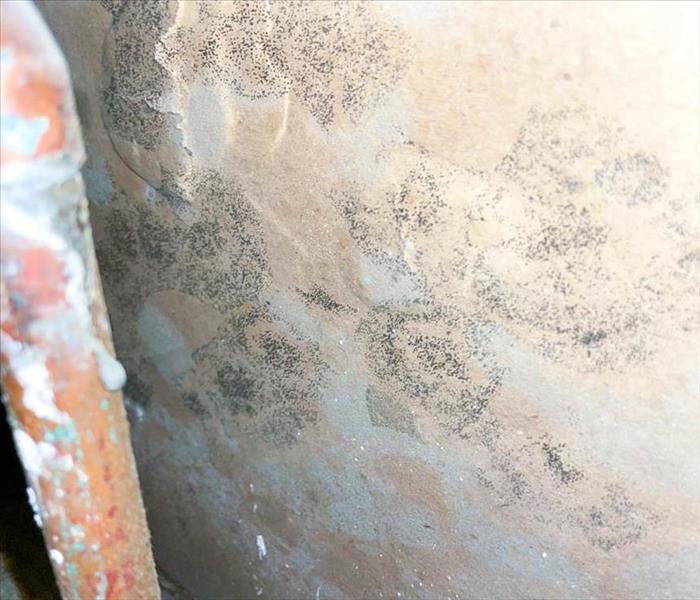 Mold is a common problem in commercial buildings, and it thrives in damp, humid conditions.
Mold is a common problem in commercial buildings, and it thrives in damp, humid conditions.
Commercial property owners and managers face unique challenges when it comes to maintaining their buildings. Mold and moisture issues can be particularly troublesome in this area due to its coastal climate. In this blog, we'll discuss the importance of mold and moisture control in commercial buildings and provide valuable tips to help you protect your investment and maintain a safe environment for occupants.
Understanding Mold and Moisture Issues
Mold is a common problem in commercial buildings, and it thrives in damp, humid conditions. Mold can cause serious structural damage, leading to expensive repairs.
Preventive Measures
- Regular Inspections: Perform routine inspections to identify any water leaks, plumbing issues, or signs of moisture intrusion. Promptly address these issues to prevent mold growth.
- Proper Ventilation: Ensure that your building has adequate ventilation to reduce humidity levels. Install exhaust fans and consider dehumidifiers in areas prone to moisture buildup.
- Roof Maintenance: Check and maintain your roof regularly to prevent leaks. Leaking roofs can allow moisture to seep into your building, creating an ideal environment for mold.
- Drainage Management: Ensure proper drainage systems are in place, and gutters are clean and functioning correctly. This will help divert rainwater away from the building.
- Seal Windows and Doors: Properly seal windows and doors to prevent water infiltration during heavy rains or storms.
- Proactive Repairs: Address any water damage or leaks promptly to prevent mold growth. Mold can start to develop in as little as 24-48 hours.
Mold Remediation
If you do encounter mold in your commercial building, it's crucial to address it immediately. Mold can cause serious property damage and can spread rapidly. SERVPRO® offers professional mold remediation services in Laguna Beach, and can help you:
- Assess and Identify: Our experts will assess the extent of the mold problem and identify the type of mold present.
- Containment: We will establish containment barriers to prevent further mold spore spread during remediation.
- Safe Removal: Our technicians will safely remove and dispose of the mold-infested materials.
- Drying and Dehumidification: We'll dry the affected areas and use dehumidifiers to prevent mold from returning.
- Cleanup and Restoration: Once mold is removed, we will clean and restore the affected areas to their pre-mold condition.
Preventive Maintenance Plans
SERVPRO® of Laguna Beach/Dana Point/Aliso Viejo offers preventive maintenance plans to help commercial property owners stay ahead of mold and moisture issues. Regularly scheduled inspections, maintenance, and moisture control can save you time and money in the long run.
Protecting your commercial building from mold and moisture issues is essential for maintaining a safe and welcoming environment for your occupants. With the right preventive measures and prompt action, you can avoid costly repairs. If you do encounter mold problems, don't hesitate to contact our SERVPRO® team for professional assistance. We're here to help you keep your property clean, safe, and mold-free!
How To Choose the Right Restoration Company in Laguna Beach, CA
10/10/2023 (Permalink)
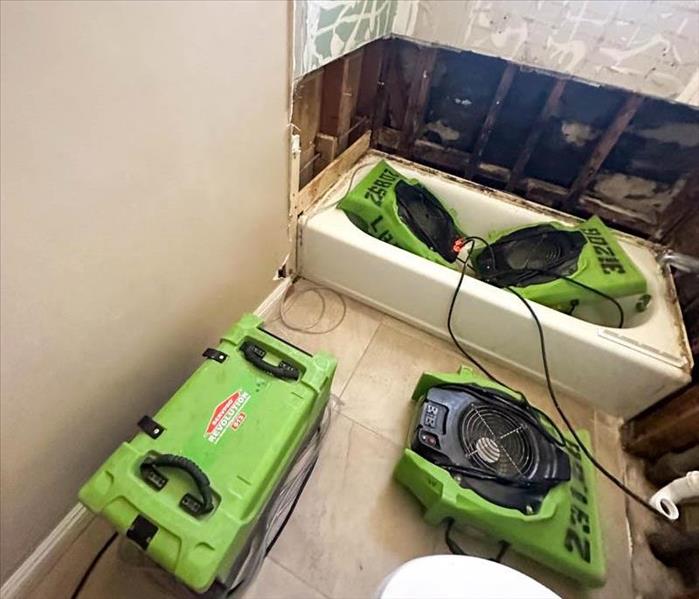 Selecting the right restoration company in Laguna Beach, CA, is a critical decision when dealing with damage to your home or property.
Selecting the right restoration company in Laguna Beach, CA, is a critical decision when dealing with damage to your home or property.
When disaster strikes, choosing the right restoration company is crucial for a swift and successful recovery. In this blog, we'll guide you through the essential steps to help you select the perfect restoration company to meet your specific needs in Laguna Beach, California.
1. Assess Your Needs
Before you start your search, assess the scope of your restoration project. Determine the type of damage you're dealing with, whether it's water damage, fire damage, mold remediation, or something else entirely. Understanding your needs will help you narrow down your options.
2. Verify Licensing and Certification
Ensure that the restoration company you choose is licensed and certified for the services they offer. This guarantees that they have the necessary training and expertise to handle your restoration project safely and effectively.
3. Local Presence
Choosing a local restoration company in Laguna Beach has several advantages. Local companies are more familiar with the area's unique challenges, and they can respond quickly to emergencies.
4. Check Insurance
Ask the restoration company about their insurance coverage This protects both you and the company in case of accidents or unforeseen issues during the restoration process.
5. Ask for References
Request references from the restoration company and follow up with past customers. This will give you insights into the company's reputation, the quality of their work, and their level of customer service.
6. Read Online Reviews
Online reviews can provide valuable information about a restoration company's performance and customer satisfaction. Check websites like Google, Yelp, and the Better Business Bureau for reviews and ratings.
7. Availability and Response Time
Emergencies can happen at any time. Choose a restoration company that offers 24/7 availability and quick response times to minimize damage.
8. Comprehensive Services
Opt for a restoration company that offers a wide range of services, including cleanup, restoration, and reconstruction. This ensures a seamless transition from damage assessment to full recovery.
9. Transparency and Communication
Clear communication is essential during the restoration process. Choose a company that communicates openly, provides detailed estimates, and keeps you informed about the progress of your project.
10. Environmentally Friendly Practices
If sustainability is important to you, inquire about the restoration company's eco-friendly practices and their commitment to minimizing environmental impact.
11. Emergency Planning
Discuss emergency planning with the restoration company. A proactive approach to disaster preparedness can save you time and money in the long run.
12. Trust Your Instincts
Ultimately, trust your instincts when choosing a restoration company. If you feel comfortable and confident in their abilities, it's a good sign that they're the right choice for your needs.
Selecting the right restoration company in Laguna Beach, CA, is a critical decision when dealing with damage to your home or property. By following these steps and conducting thorough research, you can ensure that you choose a reputable and reliable company that will help you restore your property to its pre-damage condition efficiently. Remember, when disaster strikes, SERVPRO® of Laguna Beach/Dana Point is here to support you with our expertise and commitment to quality service. Your home's recovery is our top priority, and we're dedicated to helping you through every step of the restoration process.
How to Protect Your Electronics During Storms
9/12/2023 (Permalink)
When dark clouds gather and thunder rumbles in the distance, the safety of your home becomes a primary concern. While ensuring your physical safety during a storm is paramount, it's equally crucial to consider the protection of your valuable electronic devices. In this blog, we'll explore practical strategies and actionable tips to help you safeguard your electronics from the fury of storms. From power surges to water damage, we'll delve into the intricacies of weather-related risks and equip you with the knowledge you need to weather any storm while keeping your devices intact.
Power Surge Protection
When storms bring surges in power, your electronic devices are at risk. A reliable safeguard is investing in high-quality surge protectors. These essential devices divert excess voltage away from your electronics, preventing damage caused by sudden power spikes. Remember to use surge protectors for all your major electronic devices, including computers, televisions, gaming consoles, and home theater systems. Additionally, during severe storms, consider unplugging non-essential devices to avoid potential damage from unpredictable power surges.
Elevated Placement
Another smart approach to protect your electronics is elevating them above potential water levels. Securely mounting TVs and speakers on walls keep them out of harm's way in case of flooding. Elevate other devices on shelves or cabinets to minimize their contact with water in case of leaks. This simple yet effective tactic can go a long way in keeping your electronics safe from moisture-related damage.
Sealed Enclosures
Moisture is a common adversary of electronics, often causing irreversible damage. To combat this threat, consider using sealed containers for storing smaller electronic devices during storms. Smartphones, tablets, and other portable electronics can be safeguarded by placing them in airtight plastic bags or containers. Additionally, if you have outdoor electronics like speakers or cameras, investing in waterproof covers can offer an extra layer of protection against rain and humidity.
Surge Suppressors for Data Lines
While surge protectors are commonly associated with power cords, don't forget to extend protection to data lines as well. Ethernet and phone lines can also be vulnerable to power surges during storms. To ensure comprehensive protection, use surge suppressors designed to safeguard data lines. This extra step can prevent damage not only to your devices but also to the network they're connected to, ensuring a more secure and reliable connection.
Evacuation Plan
In the event of severe weather warnings, having an evacuation plan for your electronics can make a significant difference. Designate a safe storage area where you can quickly place your devices in sealed containers or protective coverings. Creating an electronics emergency kit is also a wise idea. Include essentials like power banks, charging cables, and portable storage devices. This kit ensures that even if you need to evacuate your home, your electronics remain protected and ready for use once the storm subsides.
Professional Inspection
Once the storm has passed, it's a good idea to consider a professional inspection to ensure your electronics are still in good condition. While you might not see immediate damage, professionals can identify hidden issues that may have occurred during the storm. They can also conduct testing to verify functionality and address any issues promptly, preventing potential long-term damage that might not be immediately evident.
Safeguard Your Electronics for a Bright Future
By implementing these strategies, you're taking proactive steps to protect your valuable electronic investments from Laguna Beach's weather. Remember, preparedness is key to ensuring your devices continue to enhance your daily life, rain or shine.
For expert advice and restoration services in the Laguna Beach area, don't hesitate to contact SERVPRO of Laguna Beach/Dana Point. We're here to help you weather the storm and keep your home and belongings safe.
What to Do If Your Roof is Damaged in a Fire
8/21/2023 (Permalink)
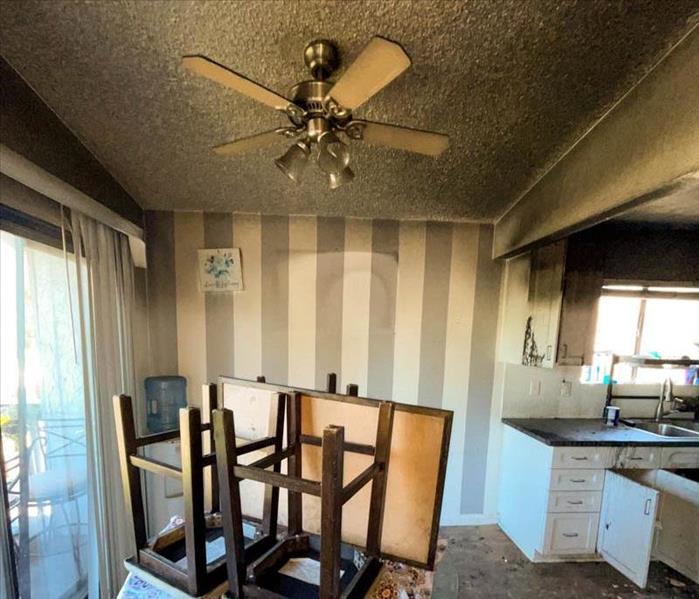 Dealing with a damaged roof caused by a fire can be a stressful and overwhelming experience.
Dealing with a damaged roof caused by a fire can be a stressful and overwhelming experience.
A fire in your home can be a devastating experience, and the damage can leave you wondering what to do next. One of the most common areas affected in house fires is the roof, and it's crucial to take immediate action to prevent further damage and ensure safety. In this blog, we'll discuss what you should do if your roof is damaged in a fire.
Safety First
The first step is to ensure the safety of yourself and everyone else in the house. If the damage to the roof is severe, it may not be safe to enter your home. Contact firefighters or professionals who can assess the severity of the damage and advise you on the next steps.
After assessing the situation and receiving the all-clear to enter your home, cover the damaged area of your roof to prevent any further damage to the interior. You can use tarps, plywood, or any other material that can protect the exposed area from rain, wind, and other outdoor elements. SERVPRO of Laguna Beach at the right equipment and expertise to assess the damage after the firefighters leave the scene.
Call Your Insurance Company
You should contact your insurance company as soon as possible to initiate the claims process if your home insurance covers damage caused by a fire. A representative will guide you through the claims process, help you understand your coverage, and answer any questions you may have.
Take photos and videos of the damage to your roof and any other areas in your home affected by the fire. This documentation can be helpful for insurance purposes, home repairs, and keeping track of any expenses incurred during the recovery process.
Hire a Professional
Repairing a damaged roof is a complex process that requires specialized skills and equipment. Hire a reputable professional roofing contractor to assess the extent of the damage, provide an estimate, and make the necessary repairs.
The process of repairing or replacing a damaged roof can take time, patience, and a willingness to work with your insurance company and contractors. Be prepared for a potentially lengthy and stressful process. However, keeping a positive attitude and being organized can help you manage your expectations and mitigate some of the stress.
Dealing with a damaged roof caused by a fire can be a stressful and overwhelming experience. Nevertheless, taking the right steps can mitigate the damage and ensure a swift and safe recovery process. Remember that safety should always be your number one priority, and always work with professionals who can guide you through the recovery process. Remember it is crucial to work with SERVPRO of Laguna Beach to ensure your property is safe and secure after a fire damage.
How to Prepare and Protect Your Home from Earthquake Damage
6/17/2023 (Permalink)
Earthquakes are unpredictable natural disasters that can cause significant damage to homes and properties. As a homeowner, taking proactive steps to prepare for earthquakes can help minimize the potential risks and protect your property. In this blog post, we'll provide you with valuable tips on how to prepare and safeguard your home from earthquake damage, ensuring the safety of your loved ones and the longevity of your property.
Understand the Risks
Start by understanding the specific earthquake risks in your area. Research local seismic activity, fault lines, and historical earthquake data to gain insights into the potential magnitude and frequency of earthquakes in your region. This information will help you assess the level of preparedness required for your home.
Secure Heavy Furniture and Objects
During an earthquake, heavy furniture and objects can become dangerous projectiles, causing injuries and extensive damage. Secure tall furniture, bookshelves, appliances, and other heavy items to the walls or floor using brackets, straps, or anchors. This precautionary measure will prevent them from toppling over during seismic activity.
Reinforce Structural Weak Points
Identify and reinforce structural weak points in your home. Consult with a professional contractor or engineer to assess the strength of your foundation, walls, and roof. Strengthening these areas with appropriate measures like foundation bolting, adding shear walls, or retrofitting can enhance the structural integrity of your home during an earthquake.
Secure Gas and Electrical Systems
Ensure your gas and electrical systems are properly secured and protected. Consult with a licensed professional to assess and reinforce gas lines, water heaters, and electrical connections. Consider installing an automatic gas shutoff valve that activates in the event of an earthquake to prevent gas leaks and potential fires.
Create an Emergency Kit
Prepare an earthquake emergency kit that includes essential supplies such as non-perishable food, water, medications, flashlights, batteries, first aid supplies, and a battery-powered radio. Store the kit in an easily accessible location, known to all household members, to ensure quick access during an emergency.
Develop an Emergency Plan
Create an earthquake emergency plan for your family. Determine safe spots within your home, such as under sturdy furniture or against an interior wall, away from windows, mirrors, or heavy objects. Establish communication protocols, designate meeting points, and educate family members on the appropriate actions to take during and after an earthquake.
Educate Yourself and Family Members
Stay informed about earthquake preparedness and response strategies. Familiarize yourself and your family with the "Drop, Cover, and Hold On" technique, which involves dropping to the ground, taking cover under a sturdy piece of furniture, and holding on until the shaking stops. Regularly practice this technique to ensure everyone knows what to do during an earthquake.
Conduct Regular Home Maintenance
Regularly inspect and maintain your home to identify and address potential hazards. Pay attention to loose roof tiles, cracks in walls or foundations, weakened structures, and damaged utility lines. Addressing these issues promptly will reduce the vulnerability of your home to earthquake damage.
Consider Earthquake Insurance
Evaluate the need for earthquake insurance coverage for your home. Standard homeowner's insurance policies often do not include coverage for earthquake damage. Consult with your insurance provider to understand the available options and consider obtaining earthquake insurance to safeguard your investment.
Preparing and protecting your home from earthquake damage requires a proactive approach and attention to detail. By understanding the risks, securing heavy furniture, reinforcing weak points, securing gas and electrical systems, creating an emergency kit and plan, educating yourself and family members, conducting regular maintenance, and considering earthquake insurance, you can significantly reduce the potential impact of an earthquake on your home. Remember, professional assistance from a reputable disaster restoration company can provide valuable guidance and support in assessing and mitigating earthquake-related risks.
Understanding the Importance of Mold Remediation: A Guide to the Process
5/9/2023 (Permalink)
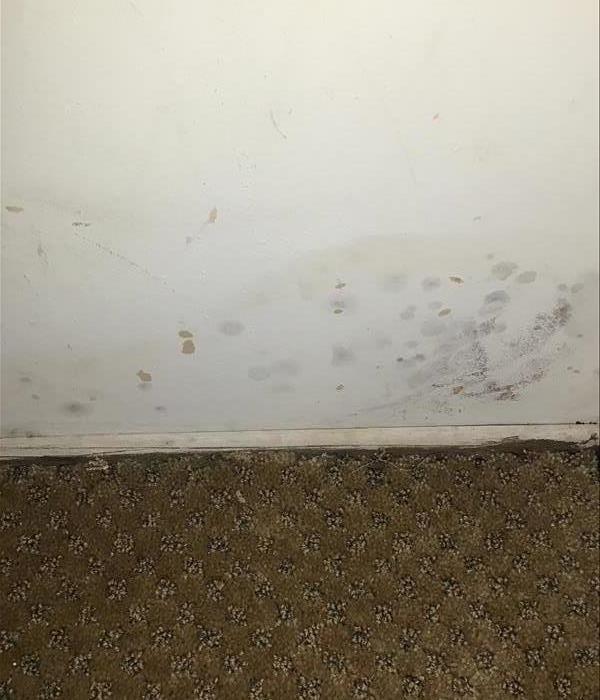 Mold remediation is an important process for removing and preventing future mold growth.
Mold remediation is an important process for removing and preventing future mold growth.
Mold is a type of fungus that can grow in damp and humid environments. If you suspect that you have mold in your home or business, it's important to address the problem quickly to prevent further damage and potential health risks. This is where mold remediation comes in.
Mold remediation is the process of removing mold from a building and preventing its future growth. This involves identifying the type and extent of the mold problem, containing the affected area, removing the mold, and taking steps to prevent it from returning. Here's a breakdown of the mold remediation process.
Assessment
The first step in the mold remediation process is to conduct an assessment of the affected area. This involves visually inspecting the area for mold growth and determining the extent of the problem. A professional mold inspector may also take air and surface samples to determine the type of mold present.
Containment
Once the extent of the mold problem has been determined, the next step is to contain the affected area to prevent the spread of mold spores to other parts of the building. This may involve using plastic sheeting to seal off the area, as well as negative air pressure to ensure that mold spores do not escape.
Removal
The mold must then be removed from the affected area. This typically involves physically removing any visible mold growth and using specialized cleaning agents to kill any remaining mold spores. In some cases, it may be necessary to remove and replace contaminated building materials such as drywall or insulation.
Drying
After the mold has been removed, the affected area must be thoroughly dried to prevent future mold growth. This may involve using dehumidifiers or fans to dry the area and reduce humidity levels. This may involve repairing any leaks or moisture problems that contributed to the mold growth, improving ventilation, and using mold-resistant building materials.
It's important to note that mold remediation is not a one-size-fits-all solution. The process may vary depending on the type and extent of the mold problem, as well as the building materials and environment involved. It's also important to work with a qualified mold remediation professional who has the expertise and equipment needed to properly address the problem.
In conclusion, mold remediation is an important process for removing mold and preventing its future growth. If you suspect that you have a mold problem, it's important to address it quickly to prevent potential secondary damage and further damage to your home or building. SERVPRO® has the experience and knowledge to return your home to its original state and prevent mold from potentially returning to your home.
5 Simple Steps to Safely Extinguish a Grease Fire in Your Kitchen
4/17/2023 (Permalink)
Cooking can be a fun and satisfying activity, but it can also be dangerous if proper safety measures are not taken. One of the most common hazards in the kitchen is a grease fire. Grease fires occur when oil or grease becomes too hot and ignites, resulting in flames that can quickly spread and cause significant damage. Knowing how to put out a grease fire is crucial to preventing injuries and property damage. In this blog, we will discuss the steps you can take to extinguish a grease fire safely.
Step 1: Turn off the heat source
The first step in putting out a grease fire is to turn off the heat source. This will prevent the fire from getting any bigger and will help contain the flames. If you have a gas stove, turn off the gas supply. For an electric stove, turn off the burner or remove the pan from the heating element.
Step 2: Cover the fire with a lid or baking sheet
The next step is to cover the fire with a lid or baking sheet. This will help smother the flames by cutting off the oxygen supply. Be sure to use a lid or baking sheet that is larger than the pan on the stove, so you can cover the entire area of the fire. If you don't have a lid or baking sheet, use a metal cookie sheet or a fire blanket.
Step 3: Pour baking soda or salt over the fire
If the fire is still burning after you have covered it, you can try using baking soda or salt to put it out. Baking soda and salt are both effective at smothering fires because they release carbon dioxide when heated, which helps suffocate the flames. Sprinkle a generous amount of baking soda or salt over the flames, being careful not to get too close to the fire.
Step 4: Use a fire extinguisher
If the fire is still burning after you have tried covering it and using baking soda or salt, it's time to use a fire extinguisher. Make sure you have a fire extinguisher that is rated for kitchen fires and that you know how to use it before you need to use it. Remember the acronym PASS: Pull the pin, Aim the nozzle, Squeeze the handle, and Sweep the base of the fire.
Step 5: Call the fire department
If the fire is still burning after you have tried all of the above steps, evacuate the building immediately and call the fire department. Do not attempt to put out the fire yourself. Wait for the professionals to arrive and let them handle the situation.
In conclusion, knowing how to put out a grease fire is essential for every home cook. Remember to turn off the heat source, cover the fire with a lid or baking sheet, pour baking soda or salt over the flames, use a fire extinguisher if necessary, and call the fire department if the fire is still burning. With these steps in mind, you can prevent injuries and property damage and ensure that everyone in your home stays safe.
Potential Shower Leak
3/7/2023 (Permalink)
You can have your bathroom checked for leaks by a professional, but there are some signs of a leak that you can check yourself. If you notice water around the base of your shower head or in the area where the floor meets the wall, it's likely there is a leak in your shower. Leaks are often caused by an improperly installed diverter valve or broken pipe, so if you find evidence of water coming from inside your wall or ceiling then this may be what's causing your problem.
You can look for signs of water in your bathroom.
You can look for signs of water in your bathroom.
If you see any water stains on the ceiling, walls or floor of your bathroom, that might be a sign that there is a leak somewhere. Water stains will appear as dark spots on drywall or plaster walls and ceilings (and sometimes even floors). The best way to tell if there are any leaks in these areas is by doing an inspection after a heavy rainfall or when it's raining outside. If you see any new water stains then there may be an issue with your roof or gutter system.
You should also check all windows in your home regularly because they're another common area where leaks can occur due to poor construction techniques used during construction time period when house was built.
The floor may sag.
Sagging floorboards. If a leak is causing your floor to sag, it will be noticeable in the form of cracks or gaps between the subfloor and drywall. Leaks can also cause your walls to bow out or crack over time due to water damage to the studs behind them, which are often made of wood that can rot over time when exposed to moisture.
Water damage under cabinets and along baseboards/door trim. If there's any evidence of mold or mildew growing where you wouldn't expect it (like under a sink), then this could be an indication that there's been some kind of leak in your bathroom or kitchen area, and possibly even down into your walls too.
Sounds of running water
When you run the shower and hear water coming from an unknown location, this could be a indication of water damage. If you hear water running in your bathroom, basement or kitchen while no other faucets are on, there's a chance that it could be a leak coming from one of these areas.
Clogged drain
If you see bubbles or white foam on the inside of your shower door or curtain, it's likely that there's a leak. These bubbles are caused by air being sucked into the drain through a clogged pipe. If you notice these signs, check to see if your drain is clogged before calling a plumber or taking other measures to fix it yourself.
A shower leak can cause significant damage to your home and property if it's not caught early enough, so it's important to know what signs to look for.
If you notice any of these signs, it's probably time to call in a professional. A shower leak can cause significant damage to your home and property if it's not caught early enough, so it's important to know what signs to look for. Give SERVPRO of Laguna Beach a call for your water damage emergency in your home or business.
Vulnerable Areas of your Home that can be Affected After a Storm
2/13/2023 (Permalink)
It's important to know what damage can happen to your home when it's hit by strong winds or heavy rain. The most vulnerable areas of the home are generally the roof, siding, gutters and downspouts, doors and windows.
What is the most vulnerable part of a home after a storm?
Your home is made up of several parts. Each part has its own unique vulnerabilities and weaknesses, so it’s important to keep your home protected from damage. Roofing, siding and gutters protect a house from the elements outside. Doors, windows and basement or crawlspace walls keep the interior dry on the inside. Damage can occur anywhere in a home during a storm because of high winds or heavy rain that falls for hours at a time. Inspect your home quickly to help prevent secondary damages to your Laguna Beach, CA, home or business.
Roof
The roof is the most vulnerable part of your home when a storm hits, and it may be the most expensive to repair. The roof can be damaged by wind, hail, rain and snow, or even ice. It can also be damaged by falling trees or branches that are too close to the house.
If you've had a recent storm and are concerned about damage to your roof, it's important to find out what type of impact it's had on your home before making repairs.
Siding
Siding is the external covering of your house. It protects your home from the elements, and can make a big difference when it comes to resale value. Siding comes in several different types: aluminum, vinyl, cedar and redwood are among the most common.
Gutters and Downspouts
When a storm hits, it is the downspouts on your house that will most likely be damaged. Downspouts are designed to have a certain degree of flexibility, but they are not meant to withstand high winds or heavy rains. If you find that your downspouts have been damaged in a storm, contact a professional contractor immediately to repair them.
Doors and Windows
Doors and windows are the most vulnerable areas of your home. Windows are often the first to be damaged by high winds, flying debris, or flooding. When you're looking for a contractor to help you repair your windows and doors after a storm, make sure they have experience with these areas of your home.
If you're looking to make your home safer in the event of a storm, it's important to know which areas are most vulnerable. Knowing what these areas are may help you determine which ones need more attention or protection. If a storm has occurred, make sure to give the professionals a call quick at the first sign of storm damage. If your looking for a professional after a storm in your local California area, give SERVPRO of Laguna Beach a call today!
What You Should Know If Your Basement Has Water Damage
1/9/2023 (Permalink)
What You Should Know If Your Basement Has Water Damage
Have you ever found yourself in a situation with water damage in your basement? Don't worry, it happens to the best of us. It can be quite annoying and sometimes even dangerous if not handled properly. In this guide, we'll go over some steps that will help you assess the damage and protect your family.
Shut off your Electricity, Gas, and Water
Before you do anything else, it's important to shut off your electricity and gas. Here's how:
- Turn off the circuit breaker or fuse box for the room where you'll be working.
- If you're using a generator, make sure that it is plugged into an outlet that isn't connected to a wall switch. This will ensure that it doesn't turn on when you least expect it!
Now that your power is out, let's move on to water supply lines:
Call a Professional
If your basement is a disaster, it's best to call in the pros. They'll have the right tools and equipment, and they'll be trained to handle whatever situation comes up. Professionals also have experience working with water damage situations, so they know what to expect when they're dealing with flooded basements or crawlspaces. Finally (and most importantly), professionals are insured for this kind of work—which means that if any damage does happen while they're on your property, their insurance will cover it.
Assess the Damage
When you find that your basement has water damage, the first thing you should do is take photos of the damage. You can use these pictures to compare against what happened later on and help you determine whether or not the problem was fixed effectively.
You should also check for mold. Mold can grow anywhere moisture is present, and it needs only a few days or weeks to spread throughout your house if left unchecked. Mold spores are very small and will often go undetected until they have grown into large colonies capable of causing sickness in humans who inhale them. If this happens, then it's time to call in an expert so they can test for any signs of mold growth and remove them before they become too much trouble!
Maybe Call Your Insurance Company
If you have a flood, the first thing to do is call your insurance company. The second thing to do is call your insurance company and make sure they will cover the damage. If it turns out that your policy doesn’t cover floods, then call your agent again and find out if there are any perks or discounts for which you qualify. For example, if you have older plumbing in your Laguna Beach, CA home (think: lead pipes), this might be enough of an excuse for them to waive some of the standard deductibles on water damage claims.
If it's bad enough, then don't worry—you won't need to deal with it yourself! Your insurance company has specialists who can handle everything from drying out soaked carpets to replacing damaged drywall and flooring with new materials that look similar but aren't actually made from toxic chemicals (like asbestos). Remember: stay calm during all this drama so that everyone stays safe until things get back on track!
Protect your Valuables
If you have valuables in your basement, make sure to secure them with plastic. For larger items like furniture, you can use a tarp or drop cloth to cover them up. If there are any drawers or cabinets in your basement, make sure to open and close them as little as possible so that they don’t get wet.
If you have a dehumidifier on hand, this would be an excellent time to use it! It will help dry out the air faster by sucking up moisture from the air and converting it into water vapor that is released outside of your home through the exhaust hose attached to the back of your machine.
If there is already moisture in your basement (or if you know that there has been flooding), it might also be helpful for you to install some sort of sump pump system right away before further damage occurs—especially if this is something that happens regularly during rainy seasons.
Document the Damage
Once you've determined where the water is coming from, it's essential that you document the damage with photos. You should take photos of the damaged area prior to any repairs or cleanup. This will allow you to compare how things were after they were repaired and how they are now—allowing you to identify whether there was further damage or deterioration as a result of these repairs. Take these photos with a date and time stamp so that they're easy to reference later on.
You should also take detailed notes about what happened before anything was fixed (if there was no actual repair), so this can be compared against both your initial documentation and any future documentation of change in status. For example: "There was standing water in front of my basement door." Compile this information into an organized logbook so it's readily accessible when needed later on down the road—it'll make things much easier for everyone involved!
Know When to Call a Professional
If you’re dealing with water damage in your home, here are some steps to take:
- Know how to shut off the water. If there is flooding in your basement or another part of your home, it is important that you immediately shut off the main valve for that area. A professional plumber can help with this process and determine what caused the initial leaky pipe or broken pipe altogether.
- Know when mold may be an issue in addition to structural damage from water damage in your basement. If the moisture level reaches 80%, mold will begin to grow on any material that has absorbed moisture into its pores—this includes items like drywall and insulation which are typically found inside walls/ceilings of homes built after 1950s-era construction standards (as well as older homes).
Remember, water damage can be devastating and expensive to fix. It’s important to take action as soon as possible so that you don’t find yourself paying for repairs down the road. If your basement has been flooded, call SERVPRO of Laguna Beach immediately!
Why is My Dishwasher Leaking?
12/5/2022 (Permalink)
Why is My Dishwasher Leaking?
If your dishwasher is leaking, it could be because of a few different things. It could be that the door isn’t properly shut, some food has gotten stuck in the drain or maybe even something broke. We have listed a few common causes below.
Has your dishwasher been leaking water?
If you have a dishwasher that is leaking water, it could be because of a number of different problems. Here are a few examples:
- A faulty part or seal may have broken
- The drain hose could have been pulled out of place
- The door was left open after it was finished running
Water Leaking from Door
If you’re noticing water leaking from around your dishwasher door, the problem could stem from one of several things. The first thing to do is inspect the seal that attaches the door to its frame, which should be made of rubber or plastic and look like a U-shaped piece. Water may be leaking because this seal has been damaged or dislodged. You can easily fix this by using an adhesive product that will secure it back in place. If this does not solve your problem and there are no visible signs of damage on either side of the seal, then you need to check for other problems such as dirt buildup around hinges, screws and joints between pieces.
Another possible issue is with your door gasket—the rubber strip at each corner where glass meets metal or plastic. If yours has been damaged or removed for some reason (such as during installation), you need to replace it before proceeding with any repairs on other parts of your machine!
Water Leaking from Bottom of Dishwasher
If your dishwasher is leaking water from the bottom, there are several possible causes. The most common reason for this problem is a leaky gasket around the door seal. This can happen due to wear and tear, or because of a sharp object such as a fork that poked through. If you see any signs of damage on your gasket, replace it immediately before proceeding with any other troubleshooting steps below.
Clogs
A clog is when there's a buildup of food particles, mineral deposits or even mold inside the dishwasher. This can occur in both the filter and drain hose of your machine. If you're able to easily remove any obstructions or blockages, then there may be nothing else that needs to be done. However, if this isn't possible, you'll need to call in a professional plumber to unclog your dishwasher.
Dishwashers are great. They help make our lives easier by doing all the hard work for us. But sometimes they can be temperamental—especially when they’re leaking water! Thankfully, there are things you can do to fix this problem without calling in a professional service provider. If your dishwasher has leaked and has damaged the floors and walls in your home or business, don’t hesitate and give our SERVPRO of Laguna Beach team a call today!
What Is The Most Common Form of Secondary Damage?
11/1/2022 (Permalink)
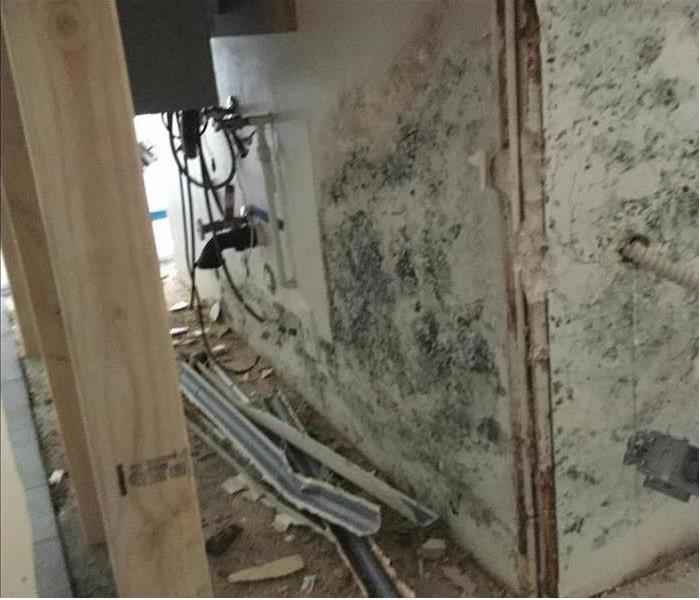 Secondary water damage can cause mold growth.
Secondary water damage can cause mold growth.
What Is The Most Common Form of Secondary Damage?
Water damage is a serious problem that can lead to secondary damage, which is often more costly and damaging than the initial water issue. In fact, mold growth and other types of secondary damage can undermine the structural integrity of your home or business. As you can see, it’s important to address any water damage as soon as possible to avoid these problems.
What is secondary damage?
Secondary damage is damage that occurs when water-damaged items are not addressed quickly enough. Remember, water can cause mold and mold can destroy your home’s structure. It’s important to get help from a professional restoration company as soon as possible.
Mold can start growing in 48 hours.
Mold needs just three things to thrive: water, oxygen, and food. If you see any of these ingredients in your home, you're at risk for mold growth. Mold can start growing in as little as 24 to 48 hours and can continue to grow for months or even years. The reason this is so dangerous is that when you have a mold problem, the spores are still there but they're just not visible. They're in your walls and they're going to keep spreading.
Mold can grow for months or even years if you don't address it. Mold remediation is an ongoing process that requires a lot of work and care. The higher the humidity, the faster mold will grow
If you find mold anywhere in or on your property (in a house or other building), call an experienced remediation company right away—time is of the essence when dealing with fungal infestation!
Dehumidifiers can help.
In areas of high humidity, dehumidifiers can help reduce humidity levels to prevent mold from growing and causing damage to the home. Dehumidifiers can also help prevent structural damage by lowering relative humidity.
If you live in a humid climate and have a leaky pipe or roof near your AC system, it's especially important that you take precautions against secondary damage to your home. A dehumidifier is an affordable and efficient way to combat this type of damage before it occurs; if you have any questions about how best to use one in your situation, consult with our SERVPRO team today!
If you see mold, it is time to call a professional!
If you see mold or notice a musty smell, call a professional like SERVPRO of Laguna Beach immediately! Mold is a fungus that feeds on organic matter. It can grow in places that are damp, dark, and warm—basements, bathrooms, and attics. Mold can cause structural damage to your home by eating away at the materials it grows on like wood, drywall, and carpet.
If you’re worried about mold, or if you just want to be sure that your home is safe from dangerous contaminants, contact our SERVPRO team today. We can help ensure your home is safe from mold and other harmful materials.
Is Water Damage Common To See After A Fire?
10/25/2022 (Permalink)
Is Water Damage Common Following A Fire?
People often associate water damage with a leaking pipe or flooding. But did you know that water damage can often be a common result of fire damage? Fire suppression systems and tactics used by firefighters to contain the fire and prevent it from spreading can result in extensive water damage. When water comes into contact with smoke or soot particles, these can be absorbed into wall coverings and other materials that are difficult to clean and dry out. This can then cause mold growth just a few days after the fire has happened.
Water damage is common to see after a fire
Water damage is often a result of fire damage. Fire sprinklers go off when a fire starts, and firefighters use water to put out the fire. When this occurs, it adds an entirely new level to the mitigation and restoration process.
Wet ceilings and walls need to be dried carefully after a fire
When a fire and water damage occur, the structure and contents of your home need to be dried out immediately. If this process is not done properly, you may be left with long-term problems: mold and mildew growth, structural damage, and other unwanted effects.
For example, ceiling tiles can sometimes be removed without causing any structural damage to walls or ceilings. However, if not dealt with carefully, removing these tiles can cause wood framing behind them to rot prematurely (or even collapse).
A certified water and fire cleanup crew can come in as soon as the fire has been put out and begin the mitigation and restoration. From start to finish, the crew will take care of your home and restore it back to preloss conditions.
Some materials are hard to dry out enough
When you've experienced fire and water damage, it's best to clean up and dry out your home as quickly as possible. However, some materials and wall coverings are hard to dry out enough to prevent mold. In many cases, materials that have been affected by fire and water damage need to be removed and replaced to prevent any further damage to your property.
Wet flooring and wet carpets must be removed as soon as possible after a fire in order to prevent secondary damage.
If you see signs of mold in your home after a fire or other natural disaster, it's crucial that you get professional help right away. Mold can cause serious damage to your property.
The next time you hear about a fire, remember that water damage is often unavoidable. Though a fire and water loss might seem devastating, just know that there are highly trained teams available to help with all the cleanup and restoration necessary. For example, SERVPRO of Laguna Beach is the leading expert in fire damage cleanup and restoration in the greater Laguna Beach area. Our team offers our services around the clock, so no matter when a loss occurs, our team is there to help!
Recover Faster with a Business Continuity Plan
8/28/2022 (Permalink)
Savvy business owners in Capistrano Beach, CA, know that the unexpected can and will happen. Instead of being caught off guard, developing a business continuity plan makes it easier to weather a disaster. Whether it is flooding that requires a temporary shutdown while a water damage and restoration professional restores the building or mechanical malfunction causes an interruption, being prepared for anything makes it easier to get back on track.
Essential Elements
A continuity plan should cover three areas:
Preparedness – Determine the potential events that could impact the business and establish protocols to minimize or eliminate them.
Response – Have clear procedures in place to handle a disaster and ensure everyone’s safety.
Recovery – Know the operations critical to success and define ways to restore them.Ensuring Success
Once those three elements are made clear, executing the plan requires communication, planning and research. To ensure its success, the following are recommended:
Build a team to oversee the process. Include key members from the departments that are critical to the overall success of the company.
Take the time to identify and rank all the what-ifs. Along with the potential effects of storm damage, consider fire risks, staffing issues, supply chain interruptions and other areas that would be the most threatening to operations.
An overall analysis of critical functions should be completed. This will help business owners rank their importance and better identify department-specific processes to ensure a smoother recovery.
Ensure you have the plan written down with each procedure clearly laid out.
Since a plan is just a plan, regular tests should be done to validate strategies. Doing so will also shed light on any missed opportunities or oversights that could be detrimental in a real situation.
Although unexpected events happen, businesses don’t have to be lost in the chaos. Stay ahead of the game by developing a continuity plan to get back on track faster.
3 Places Mold Can Hide in Your Facility
8/23/2022 (Permalink)
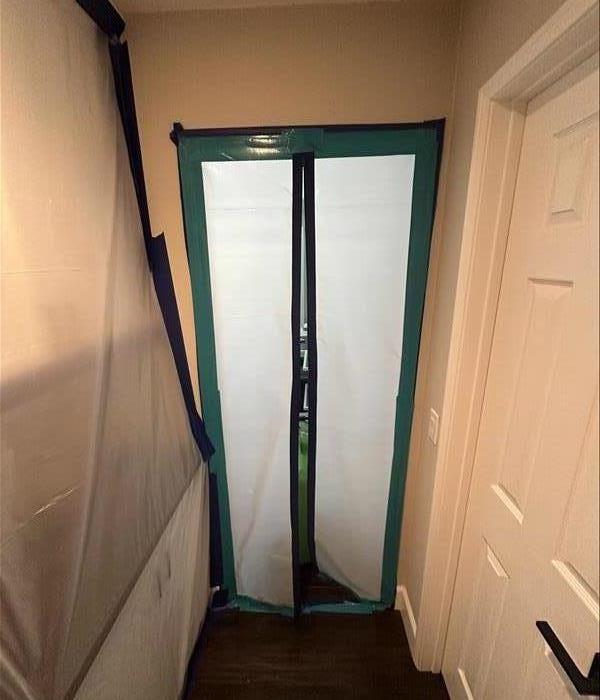 Regular inspections along with prompt attention to excess moisture can help your mold prevention plan and keep your facility in good condition.
Regular inspections along with prompt attention to excess moisture can help your mold prevention plan and keep your facility in good condition.
Here Are Three Places To Look For Mold
Mold can appear in your facility in Three Arch Bay, CA, when and where you least expect it. Mold requires four conditions for growth: darkness, moisture, organic material, and a surface to grow on. Unfortunately, most facilities have spaces that meet all of these requirements. Therefore, it's not unusual for facility managers to need a plan for remediation and mold prevention. Here are three places to look for mold.
1. Carpet
Carpet catches organic materials and hangs onto them. It can also capture moisture through:
- Leaks
- Spills
- Floods
- Moist room air
To minimize mold growth in the carpet, check room humidity levels, and adjust accordingly. If a flood has introduced moisture, use fans, dehumidifiers, and wet/dry vacuums to dry the carpet as quickly as possible. You can call a mold remediation specialist to help with the cleanup.
2. Ductwork
During the cooling season, the air supplied to the facility has a high moisture level, causing water to condense and accumulate inside duct linings. Damaged insulation can also cause moisture accumulation on duct exteriors, and leaky ductwork can allow moisture to escape into spaces with unconditioned air.
Consider having ductwork inspected regularly as part of a mold prevention plan. Also, ensure that air-flow rates are within the design range of your system. Rates that are too high can draw moisture from the face of the cooling coil and into the ductwork system.
3. Ceiling Tiles
Many ceiling tiles are made from porous materials that readily absorb dirt and moisture. Tiles near the HVAC system vents are particularly susceptible to mold growth as these areas are high in humidity and dirt.
Mechanical piping is often located above suspended ceilings, and leaks can cause moisture to accumulate inside the ceiling. Roof leaks can also lead to water damage and wet tiles. To prevent moisture from accumulating in ceilings, inspect plumbing systems regularly and repair roof leaks promptly.
Regular inspections along with prompt attention to excess moisture can help your mold prevention plan and keep your facility in good working condition.
3 Candle Safety Tips
8/11/2022 (Permalink)
Use These Tips To Safely And Properly Use Candles In Your Home
Candles can be a great, cozy addition to your home in College Park, CA. Candles have many benefits, including creating a relaxing ambiance and helping your home smell good. However, it's important to be safe while using candles to prevent a candle fire or other accident. Using a candle without proper care can quickly turn into an emergency. Be sure to use candles safely and properly to stop a preventable accident.
1. Do Not Keep Anything Flammable Near Candles
Flammable objects like curtains and loose papers can quickly create a fire emergency. If you are burning a candle, be sure to keep it away from anything that is capable of catching fire. Any liquids that are highly flammable should be kept completely clear of the candle, and you should create a plan for what to do if something does catch fire that includes calling the necessary emergency services and contacting a fire restoration company.
2. Don't Leave Candles Unattended
Leaving a candle unattended while you leave the house or even just the room can be an easy mistake to make, but it can quickly lead to a candle fire. Be sure to extinguish your candle when leaving it.
Additionally, if you have children or pets, be sure to keep them away from the candle and do not leave them unattended with the candle, either.
3. Try Candle Alternatives
There are plenty of candle alternatives that reduce or eliminate the risk of fire. For example, using battery-operated or electric candles can help eliminate the risk of a fire and smoke cleanup. If you like the scents of candles, try an essential oil diffuser or wax warmers. When you need a light source in case of a power outage, use a flashlight instead when possible.
A candle fire can spread quickly and create a fire emergency.
5 Things Commercial Owners Can Do After a Building Fire
7/23/2022 (Permalink)
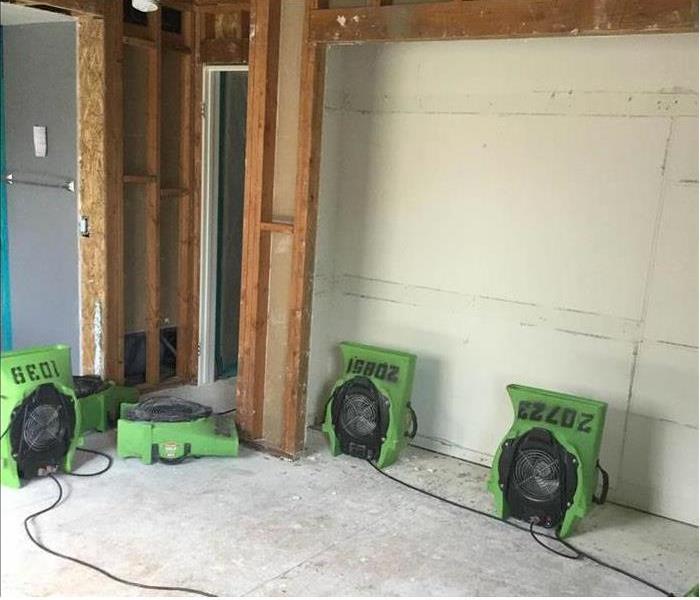 Fire restoration services in Treasure Island, CA.
Fire restoration services in Treasure Island, CA.
Five Things To Do After A Fire
Fire restoration is a complicated, multi-step process. In-depth cleaning must take place to avoid significant issues such as mold and structural loss. It's imperative that commercial owners in Treasure Island, CA, understand that this takes time and outside assistance. While owners allow professionals to tend to the facility, there are vital steps that proprietors should take. The following are five things to do immediately after the fire occurs.
1. Initiate Your Claim
Contact your insurer, and ask to use your fire insurance policy. Create a claim, and discuss details of the process. Know your deductible, maximum coverage and any exclusions. Inquire about mortgage assistance and property loss as well. Ask questions. It's better to know what the agent needs than to hope you are doing something right.
2. Gather Important Business Documents
While the building undergoes fire restoration, owners may not have access to essential paperwork. Locate your reports and accounts files. Have a copy of mortgage statements or lease agreements. Take them to a safe place for continued reference.
3. Secure the Facility
Protect the property from further harm. Contact a fire remediation company to oversee the area. These professionals arrive directly after the blaze and assess immediate vulnerabilities. The team should board up any openings and put a tarp over the roof.
The main goal here is to limit entrance. Keep others out, including curious bystanders, animals and rain.
4. Approve Remediation Efforts
Allow some work to begin before insurance approval. For instance, allowing water and smoke cleaning to start promptly could reduce overall costs, time and trouble. Save the receipts. Insurance usually compensates for it. Always speak with agents, however, to see what is required on that end.
5. Locate Temporary Workspace
The building is typically off-limits during remediation. Hunt down a temporary venue where you can set up shop and continue projects.
While specialized crews focus on fire restoration, owners should focus on insurance communication and business operations. In doing so, the operations may continue and financial help may be received.
What You Should Know About Landlord Insurance
7/14/2022 (Permalink)
What You Should Know About Landlord Insurance
Many things can be destroyed by fire damage: homes, furniture, and vehicles being among the most common. When this occurs in a rental building, there can be confusion about who pays to replace the content and hire the restoration company. In this case, a line must be drawn between the landlord and the tenants' responsibilities. Therefore, landlords need to know more about the potential expenses and who pays them.
The Expenses That Will Occur
An apartment fire will affect both the landlord and tenants in Laguna Beach, CA. While fire, smoke, and water damage are the biggest expenses, other things need to be considered. Here are some of the expenses that will occur after a fire:
- Restoration
- Legal fees
- Relocation
- Lost income
The Ways They Are Paid
Deciding who is responsible in the event of an apartment fire is complex. To completely cover the damage, there should be both landlord and renter insurance. Understanding these policies will help establish how costs are paid. This is because the landlord and renters insurance covers different things. In general, these policies cover the belongings owned by the insured.
Landlord insurance will cover the damage to the structure. Most policies will cover the building, utilities, and provided appliances. Ensure that your policy provides enough coverage to completely replace all of these items to avoid out-of-pocket costs.
On the other hand, renters insurance will cover the tenant's possessions. This includes all of the personal items in their unit. Furniture, electronics, and clothing will all be covered. Renters should have appropriate coverage to ensure they do not have out-of-pocket costs.
When an apartment fire occurs, the tenants and landlord have different responsibilities. Because of this, these individuals should have their respective insurance policies. This will prevent landlords and tenants from having out-of-pocket costs due to a fire. Knowing more about potential expenses and how they are paid can prepare both renters and landlords for disasters.
Understanding A Flood Cut In A Nutshell
7/7/2022 (Permalink)
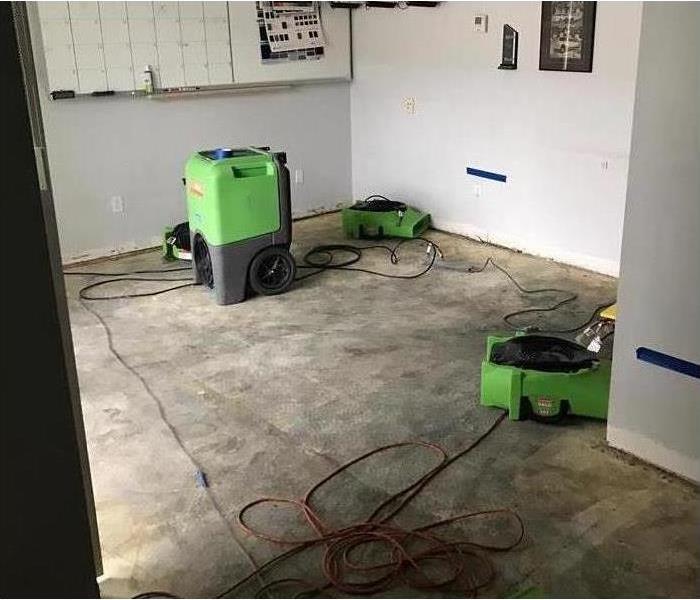 Severe floods can happen when you least expect them. The team at SERVPRO is ready to respond to any size flood in your commercial building.
Severe floods can happen when you least expect them. The team at SERVPRO is ready to respond to any size flood in your commercial building.
Understanding A Flood Cut In A Nutshell
Flooding can be a major problem for commercial buildings in Laguna Beach, CA. It can lead to structural damage, mold growth, and sewage contamination. In certain cases, your flood cleanup company may start talking to you about doing a flood cut. This term may sound daunting, but it is a simple procedure that can help speed up the remediation process for your building. Learn more about this process to figure out if it is right for your flood remediation project.
What Is It?
Simply put, a flood cut is the removal of drywall in a flooded building. If the contractor has to tear out drywall, he or she will make a cut 12 to 18 inches above the flood line. Any drywall below that line is removed from the wall.
When Is It Necessary?
This restoration procedure isn't always necessary. You may have to have it done in your building if any of the following is true:
- The wall is insulated.
- The water is contaminated.
- There is potential mold growth in the wall.
If the flooding involves only clean water, there is a greater chance that you won't have to have any of your drywall taken out.
How Does It Help?
Removing the bottom portion of the drywall allows the interior of the wall to dry out faster. It also allows the restoration experts to visually see what's going on. They may be able to see signs of mold growth or other issues. Drywall is a porous material, so it often soaks up a lot of water. If the floods in your commercial building included any black water, removing the drywall helps remove all signs of contamination from the structure.
When your Laguna Beach, CA, building is affected by flooding, you want the issue to be addressed as quickly and efficiently as possible. Tearing out most of the lower drywall may seem counterintuitive, but it can actually help speed up your building's restoration.
3 Safe Flameless Candle Alternatives
6/16/2022 (Permalink)
3 Flameless Candle Alternatives That Aren't Dangerous
As inviting as traditional candles are to create a certain appeal, they pose a safety concern. Flame-free options give you the look and feel of real candles. Here are three flameless candle alternatives to consider.
1. LED Pillar Candles
Pillar candles are one of the most common alternatives. They're available in varying sizes, colors, and scents to suit your decor. Pillars are versatile enough to sit on a mantle or in the bathroom during a soak. With an LED feature, they'll last longer than battery-operated options.
While you can light a real pillar candle, the open flame automatically puts your home in danger, especially if you get sidetracked. An unattended candle can quickly become dangerous. Never leave candles lit near curtains or bedding. Always extinguish the flame if you're going into another room or falling asleep. If the unfortunate occurs, the experts in fire damage restoration will be there to restore your home.
2. Tea Light Candle Alternatives
Placing tea lights around your home provides the appeal of real candles without the concern for safety. Their footprint is minimal, so you can place them almost anywhere without cluttering your space. Tea lights are ideal for tables as the low profile means they won’t block fellow diners from view or become obstacles when reaching for food.
3. Outdoor Solar Lanterns
Sitting outside in Aliso Viejo, CA, in the evening breeze with mood-enhancing candles on the table evokes a nice feeling. You have, however, likely experienced an uptick in the wind, which has caused your tableware to topple. Imagine this experience happening with a lit candle.
Enjoying a beautiful evening with family and friends outdoors shouldn’t be a potentially dangerous event. Instead, incorporate alternatives such as outdoor solar lanterns into your tablescape. They recharge throughout the day to be ready for the evening ahead.
Candle alternatives provide inviting options such as fragrances and the ambiance of a flickering wick without the worry of an open flame. By incorporating innovative options, candle fire concerns will be a thing of the past so you can enjoy your future.
Can You Flood-Proof Your Home?
6/10/2022 (Permalink)
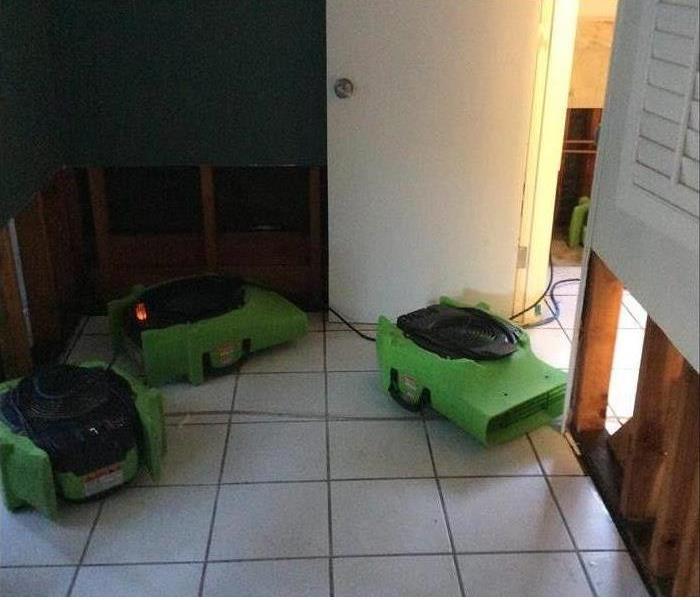 SERVPRO can respond immediately to your home or business after a severe storm. Call us when you need it!
SERVPRO can respond immediately to your home or business after a severe storm. Call us when you need it!
Is Your House Flood-Proof?
Short of buying a home that sits on the top of a hill in the middle of a desert, the best way to protect your home from flooding is to develop a good flood safety plan. Here are four safety tips you can follow to minimize costly damage to your home.
1. Elevate Your Home
If you are buying a home, check FEMA’s website to find out how high local rivers and lakes are expected to rise during a severe storm. If possible, buy a home above the flood line. If you are buying a home on a beach, you can elevate your home by setting it on piers or columns.
2. Elevate Electrical Systems
For maximum flood safety, you must ensure that electrical systems are not on ground level. Safety tips include elevating electrical wires, breakers, sockets and outlets at least 1 foot off the ground. Air conditioners, furnaces and water heaters should be elevated and secured. Generators must be installed above the flood line or else they can become damaged, useless, and possibly dangerous during a flood.
3. Protect Sewer Systems
During a flood, backed-up and overflowing sewer systems can cause unsanitary conditions that spread disease. Flood-proof your sewer system by installing backflow valves on all pipes that enter your home.
4. Make a Last-Minute Effort
If flooding is imminent, some last-minute efforts can help minimize damage to your home in Laguna Beach, CA. Clean gutters to help route the water away from your home. Try to get kitchen appliances off the ground. Move valuables upstairs or onto countertops to minimize losses.
With a little planning, you can minimize the damage your home experiences during a flood. If flood damage occurs, enlist the help of a professional storm damage restoration company to return your home to its pre-flood condition. Remember to always watch and adhere to any flood safety or evacuation warnings.
3 Ways a Company Becomes a Preferred Vendor
6/1/2022 (Permalink)
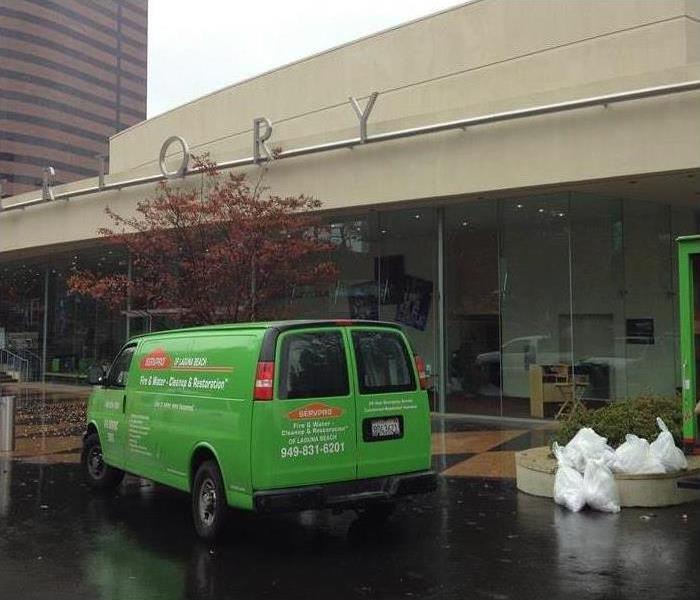 SERVPRO of Laguna Beach / Dana Point is here to make it "Like it never even happened."
SERVPRO of Laguna Beach / Dana Point is here to make it "Like it never even happened."
Three Ways a Business Can Become a Preferred Vendor
After a crisis at your business in Laguna Beach, CA, you don't want to spend time shopping around for a reliable restoration company. You want to trust that your insurance agent has your best interest in mind when they recommend a company to help you. You can trust you are in good hands when a vendor has achieved preferred vendor status with your insurance company. Here are three things vendors must do to become your insurer's preferred choice.
1. Join the Preferred Vendor Program
There are likely many restoration companies in your area, and some may have been in business forever. But it helps you as the client to have peace of mind when a company has backing from a larger certification entity. A SERVPRO franchise owner must join a national account and agree to a checklist of 21 qualifications before becoming a preferred vendor.
2. Complete All Checklist Items
Of the 21 items on the checklist, a vendor must maintain background checks on their employees, keep equipment up-to-date, and pass all audits to achieve preferred vendor status with an insurance company. Your insurance agent can see all restoration vendors in the area, but preferred vendors have completed the checklist to demonstrate that they are committed to quality service.
3. Maintain Training and Quality Service
As new technologies and research become available, most professions update their practices. A commercial restoration company is no different. To maintain preferred vendor status, franchise owners must provide continuing education opportunities to their employees. The owner also has access to the company metrics that report performance and customer satisfaction. He or she must use that data to improve the company's services to maintain a spot on the preferred vendor list with your insurance company.
Your insurance agent wants to help you recover quickly from a crisis at your business. You can trust that a preferred vendor with your insurance company has undergone rigorous testing and training to achieve that status.
What Are Storm Services and How Can They Help Insurance Agents?
5/24/2022 (Permalink)
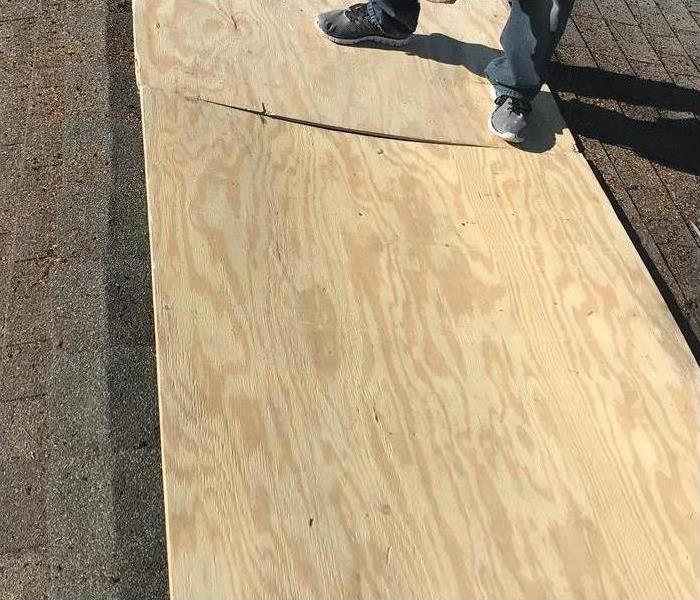 The team at SERVPRO responded and boarded up the roof after a storm in California.
The team at SERVPRO responded and boarded up the roof after a storm in California.
What Are Storm Services?
When a major storm, such as a hurricane, strikes Dana Hills, CA, insurance agents can have great difficulty in finding any storm restoration available. Not only is this vexing for your clients (as well as you), it leads to greater damage when mitigation efforts aren’t applied immediately to storm damage. You need a top restoration company as soon as possible after a disaster.
What’s First?
As soon as the storm has passed, damaged buildings will be searched by a storm response team. The next step is to secure the property. This is done in three ways:
- Reinforce the structure as necessary.
- Remove any floodwater and squeeze out the moisture.
- Tarp and board exposed areas.
That’s the job of the restoration company. They’ll bring in everything needed to reduce further damage.
What’s Next?
SERVPRO has a separate National Accounts Division to provide storm services directly to insurance agents and their clients. As a Preferred Vendor, they’re used to working closely with insurance company professionals to expedite the claim. They know exactly what forms you need and can often begin storm restoration within days – or hours!
What Do Storm Services Include?
As a Preferred Vendor, they can begin to protect the property even before the claim has been formally begun. Their top priority in a storm response is to prevent further damage.
To expedite the claim, all their files are available electronically through the cloud. With a computer or smart device, insurance adjusters and agents can share all the files instantaneously, dramatically increasing response times. It also removes any confusion or lost paperwork – and hard copies are also available, of course.
In a major disaster, SERVPRO can bring in assets from over 1,700 locations to begin the process even faster. Hundreds of local franchises will band together in a crisis to shift trained crews to where they’re needed, even for widespread flood damage.
The close collaboration between a Preferred Vendor and an insurance company ensures the highest quality storm restoration at a pre-arranged cost. It’s the best way to reduce stress for everyone involved.
Typical Standby Generator Maintenance
5/18/2022 (Permalink)
Maintenance of a Standby Generator
The typical life expectancy for a generator is between 20,000 and 30,000 hours, serving a crucial role while waiting for a storm restoration company to come to your business. If you are looking to push the maximum number of hours and avoid generator problems, you need to consider the required preventative maintenance.
Weekly
You are going to need to perform small maintenance tasks every week. These include:
- Running the engine
- Checking for alarms or warnings
- Ensuring adequate fuel levels for an emergency
- Setting the engine to auto mode
- Checking that the circuit breaker is closed
- Ensuring there are no leaks
Monthly
On a monthly basis, you will need to spend more time checking fluid levels, such as the coolant and oil. You should also check the battery to ensure you are ready for a disaster.
Bi-Annual
You are going to want to check the thermal protection levels every six months. Use the appropriate tester for the type of coolant you are running in your generator in Emerald Bay, CA. At the same time, inspect the drive belts to ensure they have the proper tension and are in good condition.
Annual
A certified technician will need to come out every year and perform crucial tasks, such as changing the engine oil, fuel filter, air filter, and spark plugs. While there, they will also clean the crankcase breather. Aside from these tasks, they will also check various aspects of your systems, such as the coolant concentration. If any extra maintenance is needed, like a coolant system flush, your technician will perform these items at your annual service. Also, if you have a diesel engine, your technician will test and condition the fuel and remove any water from the fuel tank.
This list will get you started on your generator maintenance. Taking precautions like this can have many benefits for your business. The primary one is that you put off replacing your equipment longer.
A Close Look at 3 Types of Damage From a Fire
5/10/2022 (Permalink)
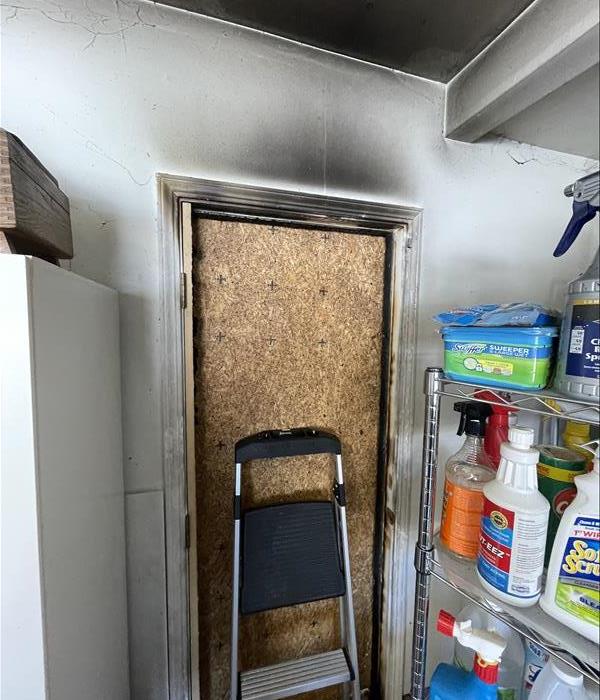 oot requires specific cleaning methods as it can penetrate porous items and find its way into the smallest openings.
oot requires specific cleaning methods as it can penetrate porous items and find its way into the smallest openings.
Three Types Of Damage From a Fire
A lot goes on in your building after a fire and it can be difficult to accurately quantify the damages amid the chaos. You might focus on the visible structural damage, but there could also be significant smoke damage that needs to be addressed. Working with a trusted local fire restoration company will help your company take care of all damage caused by a fire.
1. Soot Damage
These small, grainy particles from a fire can quickly spread throughout your building in Treasure Island, CA. Soot requires specific cleaning methods as it can penetrate porous items and find its way into the smallest openings. Just moving too freely in an area with soot can cause further spread of the particles, and using the wrong methods can cause additional and irreversible damage to equipment and sensitive systems.
2. Smoke Damage
This invisible presence after a fire poses many challenges for cleanup crews. Even after a thorough cleaning, the smoke odor can return in just a few days and linger for weeks or even months. The proper techniques and equipment are mandatory. A professional smoke cleaning includes the use of approved agents, a regimen of cleaning and sanitizing, and the cleaning of personal items. In some cases, items have to be taken off-site for effective cleaning of smoke odors.
3. Water Damage
Nearly every significant fire also results in damage from the water used by fire fighting equipment. This should be removed at once, and then the affected surfaces and items should be dried completely. Specific measures for dealing with sensitive equipment such as computers and lighting must be followed. Failure to address water damage could lead to mold growth and other problems.
Issues such as smoke damage require advanced techniques from trained professionals. Cleaning up after a commercial fire is a multi-faceted undertaking.
What Are Storm Services and How Can They Help Insurance Agents?
5/10/2022 (Permalink)
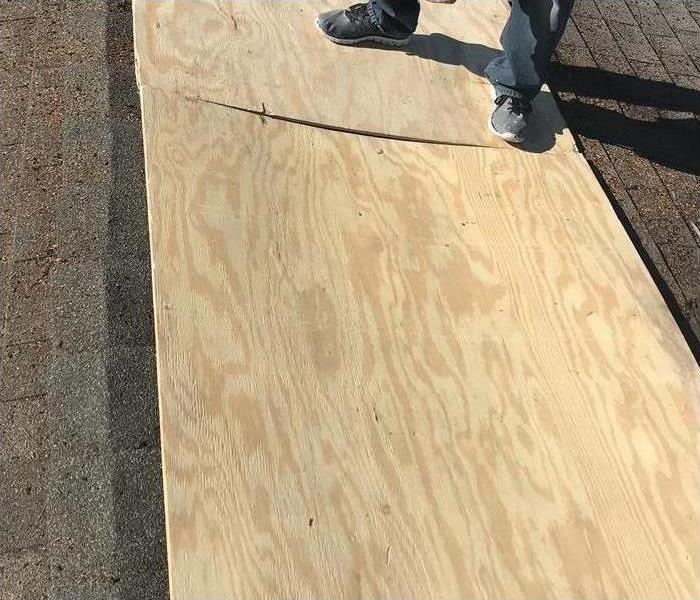 The team at SERVPRO responded and boarded up the roof after a storm in California.
The team at SERVPRO responded and boarded up the roof after a storm in California.
What Are Storm Services?
When a major storm, such as a hurricane, strikes Dana Hills, CA, insurance agents can have great difficulty in finding any storm restoration available. Not only is this vexing for your clients (as well as you), it leads to greater damage when mitigation efforts aren’t applied immediately to storm damage. You need a top restoration company as soon as possible after a disaster.
What’s First?
As soon as the storm has passed, damaged buildings will be searched by a storm response team. The next step is to secure the property. This is done in three ways:
- Reinforce the structure as necessary.
- Remove any floodwater and squeeze out the moisture.
- Tarp and board exposed areas.
That’s the job of the restoration company. They’ll bring in everything needed to reduce further damage.
What’s Next?
SERVPRO has a separate National Accounts Division to provide storm services directly to insurance agents and their clients. As a Preferred Vendor, they’re used to working closely with insurance company professionals to expedite the claim. They know exactly what forms you need and can often begin storm restoration within days – or hours!
What Do Storm Services Include?
As a Preferred Vendor, they can begin to protect the property even before the claim has been formally begun. Their top priority in a storm response is to prevent further damage.
To expedite the claim, all their files are available electronically through the cloud. With a computer or smart device, insurance adjusters and agents can share all the files instantaneously, dramatically increasing response times. It also removes any confusion or lost paperwork – and hard copies are also available, of course.
In a major disaster, SERVPRO can bring in assets from over 1,700 locations to begin the process even faster. Hundreds of local franchises will band together in a crisis to shift trained crews to where they’re needed, even for widespread flood damage.
The close collaboration between a Preferred Vendor and an insurance company ensures the highest quality storm restoration at a pre-arranged cost. It’s the best way to reduce stress for everyone involved.
3 Flood Prevention Tips for the Proactive Business Owner
4/18/2022 (Permalink)
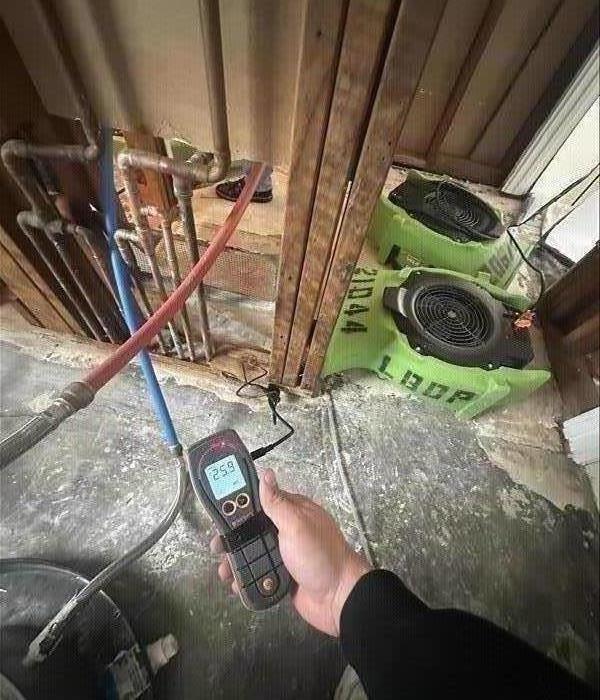 Floods cause billions of dollars in damage, leaving business owners left to deal with flood cleaning.
Floods cause billions of dollars in damage, leaving business owners left to deal with flood cleaning.
Three Flood Prevention Tips For The Forward-Thinking Business Owner
According to National Geographic, floods are the most common and destructive natural disaster. Whether it's from melting snow, a broken levee or a severe thunderstorm, floods cause billions of dollars in damage, leaving business owners left to deal with flood cleaning. Being proactive is key to protecting your property, but it can feel overwhelming. Here are three flood prevention tips to consider before the next big storm rolls in.
1. Inspect the Building Regularly
Regular assessments of your building and its surroundings are one of the best ways to avoid flood damage altogether. An inspection can reveal areas that are susceptible to water damage, and it can highlight opportunities for repairs and flood-proofing. Pay close attention to basements and other low-lying areas, and take care of any repairs in a timely fashion.
2. Clean the Roof and Gutters
Before a storm rolls through Lantern Village, CA, take some time to clean gutters, downspouts, and other drainage areas. These mechanisms are less effective for flood prevention when they're full of leaves and other matter. Keeping these areas clear will ensure that water doesn't back up into the building after heavy rain.
3. Manage the Landscape
Floodwaters move quickly, and many business owners don't realize the effect that landscaping has. Designs such as rain gardens or swales can help collect and redirect rainwater. Whatever you do, make sure the landscaping is designed so that water runs away from the property. If there's significant work to be done, hire a professional who can help design and implement a water damage prevention strategy for your building's exterior.
Being proactive about flood prevention can save you the headache of dealing with water damage on your commercial property. Maintaining your building's interior and exterior through regular inspections and cleanup is the easiest way to keep your building dry all year round. If your building has already been impacted by water damage, a flood cleanup company can assess the water damage and identify a solution.
3 Tips for Buying a Smoke Detector
4/12/2022 (Permalink)
3 Suggestions For Purchasing A Smoke Detector
Protecting your Dana Point, CA, home from the threat of fire means installing the right smoke alarm on each floor of your home. Choosing an alarm can be a puzzling process, but when you understand your options and keep a few tips in mind as you browse different styles, you may feel more confident and make the most informed choice possible.
1. Consider Your Home's Layout
Before you choose a smoke detector, think about your home's design and where units would be the most useful. For example, if you store paper goods and other items in your attic, consider installing a fire alarm there. Place them in long hallways with bedroom entrances and in bedrooms for additional protection.
2. Review Unit Life Span
Most smoke alarm brands will include the specifications for each unit, including its life expectancy. This is different from the battery life, as parts may wear out over time. If you want a low-maintenance brand, then consider buying one with a 10-year span and replace the battery at least twice a year. You can track the replacement easily by installing a new battery each spring and fall when Daylight Saving begins and ends.
3. Consider Smart Alarms
If your home is wired to your smartphone to control other alarms and lighting systems, then you may want to add one or more smart alarms to your one-touch arsenal of home security. A smart smoke alarm can alert you of a fire when you are not at home and allow you to test the unit wirelessly. You may want to consult a fire damage and restoration company about whether smart smoke alarms are a good choice for your home or if you should pair them with traditional detectors as part of your home fire safety plan.
Protecting your Dana Point, CA, home from fire and smoke damage does not need to be a confusing task. Understanding your options and considering the most efficient placement and type of alarm that can best work for you may help you make the best choice possible.
How To Know When It Is Time for a Plumbing Overhaul
4/6/2022 (Permalink)
When Is A Plumbing Overhaul Necessary?
Many people ignore the home's plumbing system until it is too late. This often leads to repeated repairs for leaks, pipe breaks and similar issues. The problem with this approach is that some plumbing issues can lead to significant water damage in a home.
Supply line damage is one example of a problem that could release hundreds of gallons into a home in Laguna Beach, CA. Though this water is likely to be clean water, it still has the power to inflict damage on flooring, walls, insulation and furniture. In some situations, a complete plumbing system overhaul might be the best solution.
Signs of Big Trouble
An occasional bathroom leak is fairly common and nothing to cause undue alarm. However, if the plumbing system experiences frequent breaks, especially in difficult-to-access locations, a replacement system might be in order. Still, it is important to carefully assess the situation by considering the following factors:
- The age of the plumbing system
- The lifespan of piping materials
- The condition of the joints and fittings
- The presence of corrosion
Each type of piping material has an expected lifespan. Supply line damage is rarer in PVC, copper and cast iron piping that is less than 50 years old. Brass and galvanized steel piping wear out more quickly.
A Reasonable Solution
While avoiding a supply line leak is important, a major replacement of plumbing is a big job. It can make sense to look for reasonable opportunities to replace plumbing components. For example, remodeling projects are great times to include a plumbing upgrade, especially if walls are being removed.
If major supply line damage does occur, calling in a water damage restoration company is the best way to avoid significant harm to a home. Trained technicians will remove standing water quickly and dry out the home to prevent future damage such as mold growth. Avoiding water damage is a worthy goal as is minimizing the consequences of a water disaster.
Roof Repair: Factors Affecting Insurance Coverage
3/24/2022 (Permalink)
Insurance Coverage For Roof Repairs: What Factors Affect It
When many homeowners think about storm coverage, they usually think about flood protection. Your home in Dana Point, CA, can just as easily suffer wind damage, though. Flying items can break windows and cause holes in your roof. There are several factors that affect whether your homeowner’s insurance covers damage to your roof and, if so, how much it covers.
Prevention Measures
Most insurance companies want to make sure the damage listed on your claim was indeed caused by wind and not the neglect of routine maintenance. There are several steps you can take to increase the likelihood that the damage will be covered:
- Quarterly professional inspection
- Impact-resistant shingles
- Regular maintenance and repair
- Proper landscaping to minimize debris during a storm
Being able to show that you have taken the appropriate precautions to minimize roof damage in the event of a storm improves your chances of being covered by your policy.
Documentation
One of the first calls you will make after wind damage occurs is to your insurance company. An adjuster will come assess the damage detailed in your claim. You probably want storm mitigation experts to start repairs before the adjuster arrives, however, to prevent further issues. It’s important to take pictures or videos of the original damage and to list all the repairs that need to be done. Document everything you list in your claim.
Value of Roof
As parts of your home age, they depreciate in value. If your roof is more than ten years old, the insurance company may not foot the entire bill, especially if you need total roof replacement. You may get partial coverage for its current value. Even if the roof is newer, the insurance company may not pay the full cost of repairs or replacement if it was significantly worn before the most current damage happened.
The best way to know how much of the wind damage repairs your insurance company will cover is to ask. Your agent can detail the factors involved in making decisions about claims.
5 Causes of Pipe Noises
3/6/2022 (Permalink)
Pipe Noises: 5 Causes
Noisy pipes can be distracting, but these sounds may also indicate an increased risk for a pipe break. Find out more about five common causes of pipe noises.
1. Abrupt Flow Stops
An abrupt stoppage of water flow may cause banging or chattering noises. Stops may be due to the manual control of faucets, malfunctioning toilet components, or appliances that draw on water.
2. Appliance Valves or Pumps
A dishwasher or washing machine supply valve may cause banging or chattering noises when the water flow shuts off. A water pump without a holding tank can make similar sounds. These noises do not indicate heightened risk of a pipe break.
3. Faucet Washer
A whistling noise may indicate that a faucet washer is distorted or that the brass screw that holds the washer in place is loose. Replacing the washer or tightening the screw should stop these noises.
4. Toilet Ballcock Valve or Overflow
A malfunctioning ballcock valve or overflow may result in hissing noises. Shut off the water supply and adjust these components or contact a plumber.
5. Vibrating Pipes
In addition to abrupt stops of water flow, excessive pressure levels can cause pipes to vibrate and may increase the risk of a pipe burst. If pipes are in good condition, a homeowner may want to consider installing anti-hammer devices, pipe straps, or specialized shock-resistant chambers to keep pipes from making contact with walls. These components may help to prevent broken pipes, severe water damage, and the need for cleanup and restoration.
Any of these factors may cause plumbing to make banging, chattering, hissing, or whistling noises. If the cause of noises is not evident after an inspection, contact a plumber in Laguna Beach, CA. Some sounds may indicate the presence of issues that can result in a pipe break and the need to fix broken pipe and restore water damage.
2 Ways To Find Out If You Have Mold
3/3/2022 (Permalink)
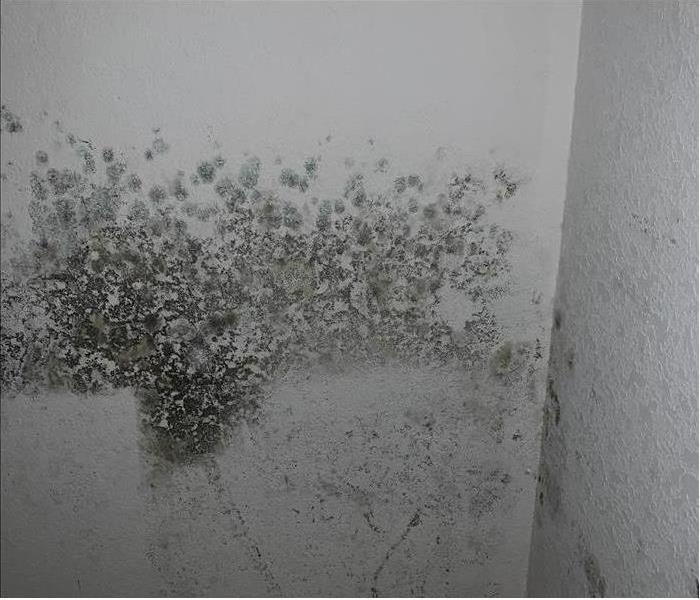 Mold infestation can quickly grow out of control. If your business is suffering from a potential mold infestation, don't wait! Call our SERVPRO team!
Mold infestation can quickly grow out of control. If your business is suffering from a potential mold infestation, don't wait! Call our SERVPRO team!
2 Ways to Determine If You Have Mold
Property owners never want to hear the news that they have a problem with mold. Unfortunately, it’s not uncommon to find mold in commercial buildings. Mold is found everywhere, including indoors and outdoors, and doesn’t cause a problem unless it is allowed to grow. Mold spores feed on moisture, which is why it’s commonly found in areas such as bathrooms and kitchens. To the untrained eye, it may be difficult to identify mold. An indoor environmental specialist is someone who has been certified on mold and moisture problems. Here are two ways to find out if you have mold in your Dana Point, CA, building.
1. Do an Inspection
One way you can find out if you have a mold problem is by doing an inspection. You can walk around your building and look for signs of mold, such as discolored ceilings and walls. It’s also possible to smell mold. An area that has significant mold growth may produce a musty odor, similar to damp, dirty socks. If you think you have a problem with mold, it’s best to get help from an indoor environmental specialist.
2. Contact a Professional
While it is possible for you to see or smell mold, it’s not advised to take care of the problem on your own. Remediating mold in commercial buildings is a major project due to the large size. Mold can spread quickly if left untreated, but thankfully mold remediation specialists are available anytime for emergency service. Once professionals arrive at your business, they will begin a thorough inspection to understand the extent of mold growth. After inspection, professionals will contain the mold, clean the air, remove damaged materials, clean belongings and restore the property.
It can be difficult to determine if there is a mold problem at your Dana Point, CA, business. Fortunately, an indoor environmental specialist can conduct a mold test even if there is no visible sign of mold. Rely on trusted professionals to help you remediate a mold problem.
Flush Your Water Heater As a Gift to Your Guests
2/10/2022 (Permalink)
As A Courtesy To Your Visitors, Flush Your Water Heater.
’Twas the eve after guests arrived and all through the house, nobody could shower, not even grandma. When was the last time you flushed the water heater at your house in Aliso Viejo, CA? If it was more than a year ago, it’s time. If you’ve never flushed it, you may receive a rude awakening at the worst time possible.
Yes, You Can!
Forget table cloths and napkins, and listen up! You are probably thinking of reasons why you can’t do this now, but you don’t want your houseguests to go without showers for the holidays. Here are some dispelled myths about flushing a water heater.
• Myth: You are too busy.
• Fact: If you have time to drink some coffee, then you have time to do this. Most of the job involves waiting.
• Myth: It’s too much work.
• Fact: Your job is to hook up a hose and turn a knob. Gravity does all the hard work.
• Myth: You don’t know how.
• Fact: You are about to learn.
How To Do the Flush
It may sound like a cool dance, but it doesn’t take that much energy to flush a water heater. Here are the steps:
- Find the breaker and shut down the power.
- Attach a hose to the faucet at the bottom of the tank.
- Turn the spigot and watch it flow!
- Open the pressure release valve at the top and turn on your kitchen faucet to hot.
- Close the water supply valve.
When it’s all done, it’s time to close any valves you opened and fill the tank again. The water and the hose are very hot, so be careful. Finally, turn on the power when the tank is completely full.
Help During the Holidays
A water heater flush is easy. Water-related destruction is much more difficult to deal with because of the varied materials involved and the risk of secondary damage from mold. You can call a water remediation professional to help see you through the disaster recovery, so you can go back to sipping eggnog by the fire.
Does Your Homeowner’s Insurance Policy Cover Fire Damage?
2/2/2022 (Permalink)
Is Fire Damage Covered by Your Homeowners Insurance Policy?
Recuperating from the loss associated with a home fire in Laguna Beach, CA, is hard enough on its own without trying to figure out what your homeowner’s insurance policy covers. While the fire restoration company will take care of repairing the damage to your home and restoring it to its original condition, it will be up to you to contact your insurance company to find out what’s covered. Here are the basics of what your home insurance will typically cover and what specific circumstances they won’t.
What Your Insurance Will Cover
Most common causes of a home fire are covered by a majority of insurance policies. Examples of scenarios where your home and personal belongings would be covered include:
- Cooking fires
- Accidental cigarette fires
- Fires caused by children or pets
- Electrical fires
- Lightning and storms
Basically, if the fire happened due to circumstances out of your control or because of an accident, you will almost always be covered.
What Your Insurance Doesn’t Cover
There are two main exceptions that a basic homeowners insurance policy won’t cover.
Arson
If you for whatever reason decided to set fire to your own home, insurance will understandably not cover the costs of the damage. You might wonder why someone would purposely destroy their home; often, this occurs because people want to collect the money insurance gives for the damages.
Vacant Home
A vacant home fire is another situation that your insurance will not cover. If no one has entered your home for 30 days straight, it is considered vacant. However, you can purchase an endorsement to your policy to cover a vacant home. This is useful if you have a vacation home or property you only visit occasionally.
Although certainly a stressful situation, is it reassuring to learn that a home fire is almost always covered by your insurance policy! Unless arson was involved or your home was vacant at the time of the fire, you can expect to receive some substantial compensation for the damage that occurred.
IICRC Sets a High Standard for Inspection, Cleaning and Restoration
2/2/2022 (Permalink)
Inspection, Cleaning, And Restoration Are Held To A High Standard By The IICRC.
Nearly everyone respects certification. It gives businesses and trained professionals credibility in the marketplace. It gives customers confidence in the qualifications of those holding the certification. IICRC is the gold standard for certification in the inspection, cleaning and restoration industry.
The Institution of Inspection Cleaning and Restoration Certification is more than just another credential. People and businesses earn and keep this certification through:
- Education
- Initial certification
- Continuing education
- Membership
Comprehensive Certification Offers Clients Peace of Mind
Comprehensive certification is not a single certificate. There are at least thirty different categories of inspection, cleaning and restoration certificates available. The institute provides training and testing for each one. It awards students a mitigation certificate upon successful completion of each category.
An IICRC certified provider employs professionals with one or more mitigation certificate. Each inspection, cleaning or restoration job requires a combination of certified skills. The business assembles a team with the appropriate skills and dispatches them to the job. The mix of professionals on the job changes as the list of required skills changes.
Happy Clients Are the Foundation of a Certified Provider
A provider may survive with an occasional unhappy customer. A provider cannot survive without its certification. A certified provider holds itself and its employees to a high standard. This high standard is what certification is all about. Failing to meet this standard jeopardizes the value of the certification for others. This failure can lead to discipline and, eventually, revocation of the certificate. Without that, the provider is out of business.
The same level of standards applies to individuals and their certifications. Revocation is a real possibility if there are problems. It makes attaining employment in the inspection, cleaning and restoration industry difficult.
Certification Is a Key to Provider Selection
Find an inspection, cleaning and restoration provider with an IICRC, and you are off to a good start. Next, you want one located nearby in the Dana Point, CA, area. Confidence in the provider will give you confidence in the quality of the job once it is complete.
Beyond Routines: 4 Tools to Prevent Basement Flooding and Backups
1/13/2022 (Permalink)
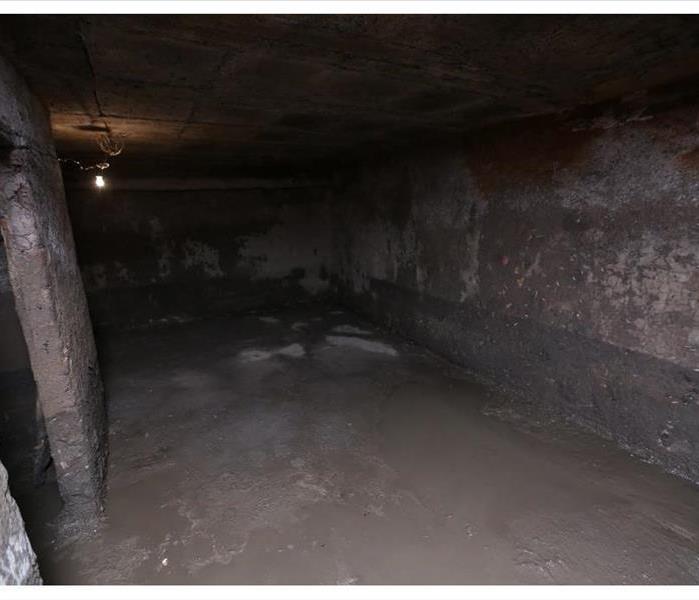 When you find flooding in your home after a storm, be sure to call the trained experts at SERVPRO for mitigation services.
When you find flooding in your home after a storm, be sure to call the trained experts at SERVPRO for mitigation services.
4 Tools To Prevent Basement Flooding And Backups Beyond Routines
A sewer backup can cost thousands to repair and remedy. In Laguna Beach, CA, regulations and even insurance policies may require a contract with an emergency restoration company due to the contamination of black water and the subsequent health risks. Fortunately, there are several steps you can take to prevent this type of flooding.
• Regular Sewer Cleaning
• Biannual Inspections
• Routine Debris Removal
Beyond these basic routines, there at least four tools you can install as preventative measures.
1. Backwater Valve
Requiring a licensed plumber for installation, a backwater valve is installed at the exterior of the building and connects to the waste line. The valve allows sewage to exit a property, but it closes and blocks sewage from backing up into the home.
2. Standpipe
A standpipe is just as it sounds. It is a pipe that stands a minimum of 3 feet out of a drain and is sealed around the base. When a backup occurs, the water rises in the pipe but does not spill out onto the floor, unless the flood is especially deep. A standpipe does not require professional installation.
3. Overhead Sewer
Another tool requiring professional installation, the overhead sewer works in conjunction with a sump pump to eliminate the risk of storm damage due to flooding. In this system, the sump pump forces water into overhead pipes that are connected into the wastewater lines, where the water flows out and away from the home.
4. One-Way Drain
A one-way drain is the simplest of all the preventative measures. This tool uses a floating mechanism to block the drain, preventing backflow. If water begins backing up, the float seals the floor drain. When water subsides, and pressure normalizes, the float lowers and allows for normal drainage.
A sewer backup can cause a significant amount of damage and can leave homeowners scrambling for solutions in a reactionary way. Fortunately, there are numerous ways to be proactive about this type of dilemma. While routine maintenance and inspections are excellent ways to ensure functionality, the four tools above offer the ability to prevent significant damage when all else fails.
What to Know About Water Damage and Your Insurance Policy
1/1/2022 (Permalink)
Water Damage And Your Insurance Policy: What You Should Know
When the cold hits, your Laguna Beach, CA, home could be facing issues with bursting pipes. Fortunately, your insurance policy can help. Here are a few of the common questions people have with filing a claim for water damage.
1. What Damage is Covered?
When it comes to damage caused by water in your home, several causes may be covered by your insurance. Sudden damages such as sewer back up, an accidental break in the plumbing, storm caused damage, or flooding are all instances insurance companies usually cover. Gradual damage which occurs over time is usually considered neglect on the part of the homeowner and will most likely not be covered. This is why it’s important to conduct any repairs as soon as water caused damage is found.
2. What Other Services May Be Covered?
Your insurance provider may also include coverage for the cost of hiring a professional cleanup and restoration service to help restore your home. These professionals can assess the damage and formulate a plan for repair and restoration. Your insurance company may also be able to help you contact a plumbing professional who can help fix broken pipe issues in your home to help prevent further problems with bursting pipes.
3. What Things Can You Do?
Aside from fixing any damage you find as soon as you can, there are a few things a homeowner can do to help the insurance process. The first is to understand your policy, and what it covers and does not cover. It may also be helpful to conduct a home maintenance check regularly and maintain a record of all your home repairs.
If you’ve had issues with bursting pipes, it’s important to know what type of water damage your policy covers. Your policy may also offer coverage for the costs of hiring professionals to help restore your home after the damage occurs. Remember, it’s important to know what's in your policy when filing a claim.
Fire Restoration: Understanding the Costs
1/1/2022 (Permalink)
Understanding The Costs Of A Fire Restoration
A commercial fire can leave a property owner confused and feeling desperate and afraid. Fear of losing their business due to a lengthy restoration can leave some wondering if it is worth it. Thankfully, insurers do offer some salvation, but understanding the costs of a renovation and how a company comes up with an estimate will help owners understand the full picture.
1. Security and Surveillance
Fire damage can leave your property vulnerable to all sorts of criminal activity, which is why security and surveillance are so vital to the rebuilding process. Any restoration company worth their salt will provide fencing and board-up services. Some companies will even offer 24-hour surveillance to ensure the safety of your property.
2. Debris Removal
An estimate will include a ballpark figure for the removal of all debris. This price is not set in stone because not all damage is immediately visible. Additionally, it is possible that while some items may look beyond repair, closer inspection reveals a different story altogether.
3. Odor Removal
Smoke and fire leave a distinct odor and residue that is not easily removed. You will likely need a company with specialized equipment and cleaning supplies to remove the odors completely, and it may take them several passes before the smell is completely gone.
4. Cleaning, Restoration and Reconstruction
A disaster restoration specialist in the Dana Point, CA, area is likely equipped to handle any size cleanup and remediation. They will also act as an intermediary between you and other contractors as you move through the cleaning, restoration and reconstruction process, ensuring your interests are the priority.
A fire is frightening and disastrous, and for businesses, it can mean significant loss if not handled appropriately. Understanding the remediation process, along with the costs associated with the initial estimate, will provide you with a clearer picture of how your business is being rebuilt.





 24/7 Emergency Service
24/7 Emergency Service












